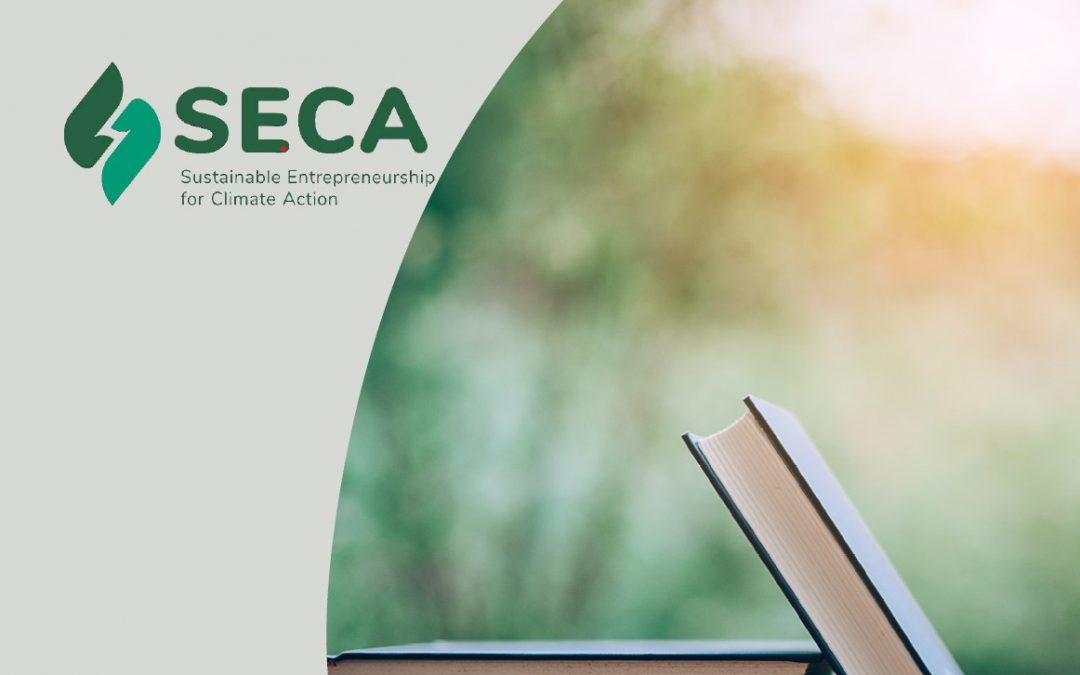
Authors:
- Constanze Chwallek, PhD, professor for Business, Entrepreneurship, FH Aachen University of Applied Sciences
- Lara Nawrath, research assistant, FH Aachen University of Applied Sciences
- Anzelika Krastina, senior lecturer, Lapland University of Applied Sciences
- Ieva Bruksle, lecturer, Turiba University, chairperson of the board of the of Latvian Economists Association
Contributions by:
- Oliver Fuchs, head of International Faculty Office, Faculty of Business Studies, FH Aachen University of Applied Sciences
- Eeva Helameri, specialist, project manager, Lapland University of Applied Sciences
- Anete Hänninen, specialist, Lapland University of Applied Sciences
- Kristine Neimane, head of Project Department, Turiba University
- Tuija Kuisma, senior lecturer, Lapland University of Applied Sciences
Type: Monograph
Publisher: Lapin ammattikorkeakoulu Oy / Lapland University of Applied Sciences Ltd
Year of publication: 2024
Serie: Pohjoisen tekijät / The Northern Factors – Publications of Lapland University of Applied Sciences 3/2024
ISBN: 978-952-316-514-4 (pdf)
ISSN: 2954-1654 (on-line publication)
PDF file: https://www.lapinamk.fi/loader.aspx?id=5e18d56b-404e-45b2-8006-c48402eeb3e3
Rights: CC BY 4.0
Language: English
Table of Contents
1. Definitions and terminology
1.1 Social Entrepreneurship and Sustainable Entrepreneurship
1.1.1 Academic differentiation
1.1.2 Country-specific use of the terms Social Entrepreneurship and Sustainable Entrepreneurship
1.2 Understanding the sustainability related Frameworks SDGs, CSR and ESG
1.2.1 SDG-Framework
1.2.2 CSR-Framework
1.2.3 ESG-Framework
1.2.4 Attempt of Differentiation of frameworks
1.3 UN – Sustainable Development Goals and their connection to climate change
1.3.1 Mapping the SDG to ESG
1.3.2 Detailed consideration of the SDG 13 Climate Action
1.3.2.1 Climate Action and the targets
1.3.2.2 Climate change mitigation vs. Climate change adaptation
1.4 The Paris Agreement as a milestone for climate change
1.6 Terminology related to Sustainable Entrepreneurship
1.6.1 Environmental
1.6.2 Ecopreneurship
1.6.3 Zero waste
1.6.4 Zero emissions / Net Zero Carbon Emissions / Climate Neutrality
1.6.5 Circular economy
2.2 International standards for sustainable business practices
2.2.1 Extended producer responsibility (EPR)
2.2.2 ISO 14000 standard for environmental management certification
2.2.3 ISO 14001 environmental management system
2.2.4 ISO 14040 Life Cycle Assessment (LCA)
2.2.5 ISO 14044 Life Cycle Inventory Analysis (LCI)
2.2.6 ISO 26000 standard as a guideline for social responsibility
2.3 Strategies on Climate Change
2.3.1 McKinsey on Climate Change (2020)
2.3.2 Getting Ahead of the Curve: Corporate Strategies that Address Climate Change
3.1 Ecosia
3.2 Everwave GmbH
3.3 Babor Beauty Group
3.4 Ellen MacArthur Foundation
3.5 Traceless Materials GmbH
3.6 reCup Gmbh
3.7 Haribo
3.8 MÁDARA Cosmetics
3.9 Rimi Baltic
3.10 Airbaltic
3.11 Omniva
3.12 Hyrogas
3.13 TerraWaste
4.1 Overlook
4.2 Inform Software GmbH
4.3 Mäurer & Wirtz
4.4 Circonomit Gmbh
4.5 Enactus (RecyCoal)
4.6 Reindeer Farm
4.7 Sampokeskus/Citycon
4.8 International College of Cosmetology
4.9 SilJa Ltd
4.10 SAKRET Ltd
4.11 Main Findings
5.1 Impact Business Model Canvas
5.2 Flourishing Business Canvas
5.3 Triple Layered Business Model Canvas
5.4 Zero Canvas
5.5 Lean Impact Canvas
5.6 The 4 Cs of environmental business
5.7 Problem tree analysis
6.1 Simplified GHG Emissions Calculator
6.2 Scope 3 Evaluator
7. Developing and piloting sustainable entrepreneurship training
7.1. Summer School on Sustainable Entrepreneurship
7.2. Summary of feedback by participants
7.3. Development Proposals
Introduction
The pursuit of sustainable entrepreneurship requires a multifaceted understanding of terminology, frameworks, and strategies. This study navigates through the diverse landscape of sustainable entrepreneurship, exploring the definitions, international standards, best practices, interviews with companies, methodologies, and tools used for the development of sustainable business. It is called as supportive research due to the main purpose of the study – to provide a knowledge foundation for better understanding of the field of sustainability. This research is expected to support the development of meaningful and practical sustainable entrepreneurship training material, that can be used by the universities or anyone interested in increasing the competence of sustainable business.
The supportive research is conducted as a part of Erasmus+ project Sustainable Entrepreneurship for Climate Action. The project addresses climate change challenges and aims to increase green skills and competencies in sustainability among current and aspiring entrepreneurs. The follow up of this research is the development of digital handbook on how to innovate sustainable businesses for climate action.
The research starts by interpreting the nuances between Social Entrepreneurship and Sustainable Entrepreneurship, while untangling the country-specific usage of these terms. Furthermore, it clarifies the significance of sustainable frameworks such as SDGs, CSR, and ESG, delineating their interconnection and distinct attributes. Further it is analyzing the UN’s Sustainable Development Goals and their profound link to climate change, particularly magnifying the pivotal role of SDG 13 – Climate Action. It dives deeper into Climate Action’s targets, differentiating between climate change mitigation and adaptation. Moreover, it highlights essential milestones like the Paris Agreement and the EU Green Deal, framing their significance in combating climate change. Section 1 wraps up with a comprehensive review of terminology, encompassing environmental aspects, ecopreneurship, zero waste initiatives, and the paradigm of circular economy.
Section 2 guides the reader towards the establishment of standards and strategies, surveying the EU Taxonomy and international standards essential for sustainable business practices. Notably, it scrutinizes extended producer responsibility, ISO standards for environmental management, life cycle assessments, and the ISO 26000 standard as a compass for social responsibility. Furthermore, the section strategically unveils corporate strategies addressing climate change, amplifying the insights from McKinsey and seminal strategies essential for climate change mitigation.
Transitioning into Section 3, a panorama of best practices emerges, spotlighting organizations exemplifying sustainable entrepreneurship. From innovative eco-friendly initiatives by Ecosia and Ellen MacArthur Foundation to the strategic sustainability endeavours of Haribo and AirBaltic, these case studies showcase diverse models of sustainable business.
The narrative unfolds further in Section 4, where interview results offer a glimpse into various organizations’ sustainable practices and insights. The comprehensive methodology and tools employed in Section 5 and Section 6 equip aspiring entrepreneurs with impactful canvases, analysis methods, and tools for sustainable business development.
Finally, in Section 7 the study is envisioning the development and implementation of a sustainable entrepreneurship training programs that are developed based on this research. Intensive one-week study programs have been piloted and iterated several times and based on past experiences, the study proposes a format of one week intensive programme methodology that can be implemented by universities for sustainable entrepreneurship education.
1. Definitions and terminology
1.1 Social Entrepreneurship and Sustainable Entrepreneurship
Social entrepreneurship and sustainable entrepreneurship are two related but distinct concepts that have been the subject of academic research and practical applications. In the following, the differences between these two terms in academic and practical terms will be elaborated.
1.1.1 Academic differentiation
No consistent understanding of the terms has yet been established in the literature. One difference is seen in that social entrepreneurship is focused on creating social or environmental impact, whereas sustainable entrepreneurship is focused on creating economic, social, and environmental value in a balanced manner. Both concepts have the potential to create positive change, but they may require different approaches and strategies and have also consequences to innovation, governance, stakeholder engagement and impact measurement.[1] Social Entrepreneurship seeks alternative methods of leveraging opportunities that create positive social benefits (for example social “intrapreneurship,” community-based businesses, nonprofit organizations). It also aims to find charitable motivations in entrepreneurship by placing a social agenda before the financial goals. Social Entrepreneurship has its disciplinary roots in the nonprofit and public sector. Developing strategies to comply with sustainable laws and objectives through endeavors like urban planning and transit, local and individual lifestyles, and ethical consumerism is the focus of sustainable entrepreneurship. Sustainable Entrepreneurship has its roots in sustainable development, innovative systems and transition management. [2]
Following Oestreicher (2017), who refers to several scientific sources, social entrepreneurship and sustainable entrepreneurship can be distinguished as follows[3]:
- Social entrepreneurs have certainly also anchored sustainability as a fundamental value. It should also be noted that “social” does not mean “social”, but rather “societal” or “oriented toward the common good”. Therefore, the terms are closely related. However, it is still possible to identify certain differences.
- Social entrepreneurs are more “mission-driven,” pursuing the fulfilment of a mission. Sustainable entrepreneurs are more profit-oriented. Sustainable entrepreneurship is limited to profit-oriented and hybrid organizations.
- Sustainable entrepreneurship is guided by the “triple bottom line” of economic, social and environmental goals. The majority of social entrepreneurs often focus on another goal, usually social, in addition to the economic goal to ensure the survival of the company or institution. Non-governmental organizations are to be considered separately, but can also be attributed to social entrepreneurship.
- Intergenerational: Sustainable Entrepreneurship as well as future generations should be taken into account. Social entrepreneurs tend to focus on present problems.
There is also a scientific debate whether sustainable entrepreneurship is a type of social entrepreneurship because the benefits of sustainable actions are also social or whether sustainable entrepreneurship is to be seen as the superior term because the implications are social as well as economic and environmental.[4]
1.1.2 Country-specific use of the terms Social Entrepreneurship and Sustainable Entrepreneurship
In Germany, the term social entrepreneurship is used as an overarching term, following the academic debate mentioned above. As stated by the Social Entrepreneurship network Germany (SEND e.V.) “the primary goal of social entrepreneurship is to solve social challenges. This is achieved through continuous use of entrepreneurial means and results in new and innovative solutions. Steering and controlling mechanisms ensure that the social goals are lived out internally and externally”. This is a definition recognized by the politics throughout Germany, here sustainable entrepreneurship is often seen as a sub topic of social entrepreneurship.
When looking into sustainable entrepreneurship in Finland, they appear to have many different meanings and words for the topic. Most areas when looking into the topic seem to focus more on people rather than climate action (Kestävän yrittäjyyden). One area of sustainable entrepreneurship is social sustainability. Social Sustainability refers to human rights, equality, employee training, well-being at work and employment relationships. Social Sustainability is often only visible to employees and reflected on customers as a responsibility. The company is always responsible for product safety, marketing promises and consumer protection. When social sustainability is strong in the company, this guarantees the employee a safe, good atmosphere, an encouraging and educational workplace. The company’s partners are equal, non-corrupt and the activities between them are responsible. Respect for equality is also reflected in the workplace’s staff, as their activities include the employment of immigrants and young people. The company has the opportunity to learn a job without full qualifications, as well as the opportunity for an apprenticeship. Offering an apprenticeship contract talks about the company’s training opportunities and the quality of the training”. Overall, Finland is a very progressive country for sustainable entrepreneurship. It is in the top 10 for most sustainable countries, and Finland has further plans to improve.[5]
In Latvia Entrepreneurship means managing risks and processes with the aim of achieving the long-term survival of the company, while taking care of the environment and society.[6] It is defined, that sustainable Entrepreneurship have 4 pillars: economic prosperity, social justice, environmental protection and culture in the community.[7]
To sum it up, every country has certain differences in their perspective of the terms social and sustainable entrepreneurship and there is not a single definition of these two terms that is acknowledged in all European countries.
1.2 Understanding the sustainability related Frameworks SDGs, CSR and ESG
Various concepts have become established in the field of sustainability, which are strongly related. They will be briefly explained before an attempt is made to draw a distinction.
1.2.1 SDG-Framework
The SDGs are the 17 Sustainable Development Goals developed in 2015 to advance global human rights, combat poverty, and increase social responsibility for climate and environmental protection, production, and consumption. They are the most ambitious plan of the world community, agreed upon by 193 countries. Since the goals are to be achieved by 2030, they are also called Agenda 2030. Politicians, institutions and Businesses must develop their sustainability strategy based on the 17 goals and 163 subgoals and align their activities with a particular aim if they intend to contribute to sustainable development. An organization can then make sure that it takes the current problems of sustainable development into account.[8]
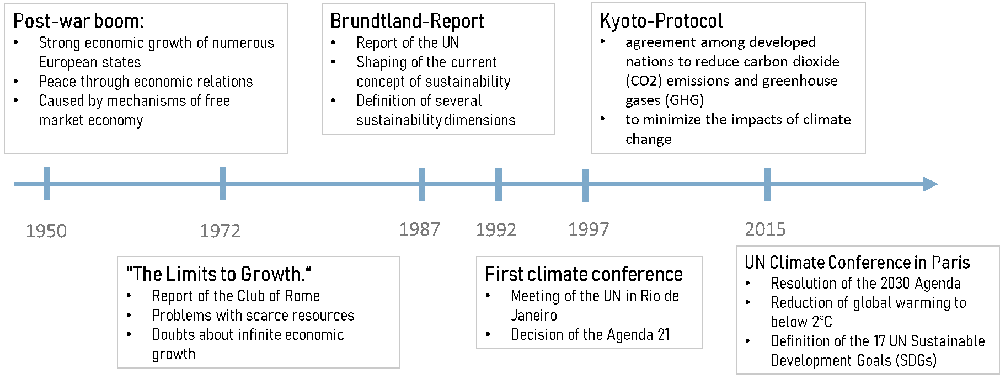
Figure 1: Emergence of the SDGs – Key Milestones. Source: own illustration
1.2.2 CSR-Framework
The Concept of Corporate Social Responsibility (CSR) goes back to Howard Bowen 1953[9] and can be seen as a management strategy that sets companies for voluntarily engaging with social interests, environmental aspects, and relations with different stakeholders, including employees. Organizations executing CSR strategies are open and get involved in dialogue with stakeholders as well as demonstrating concern for the environment and the general state of the economy. While turning a profit is still important, there is just as much effort put into maintaining good relations with clients, employees, local communities, and shareholders. It is the positive impact on society that is the most distinguishing feature of CSR, where the company becomes a defining subject of its environment and a patron of the local market. The term Corporate Social Responsibility (CSR) has been avoided as it is often interpreted to only cover aspects of the social dimension and be related to philanthropic activities.[10]
1.2.3 ESG-Framework
The ESG concept encompasses the environmental, social and governance aspects. Environment includes the steps a company takes to protect ecology and the environment, such as treating wastewater and minimizing gas emissions. Social describes the actions a company takes to uphold human rights, maintain positive relationships with communities, provide adequate and fair wages and benefits to employees, and responsibly protect customers.[11] Governance refers to aspects such as executive compensation, donations, political lobbying, tax strategies, diversity on boards of directors and supervisory boards, corporate structure, corruption and bribery.
ESG is a defined term based on numerous regulations and using data from inside and outside the company. It is these aspects that a company should focus on if it wants to attract customers and, more importantly, investors. ESG is now an important factor in business decisions and has a decisive impact on company value, investment decisions or even interest rates on bank loans. Typically, rating agencies such as S&P evaluate ESG scores as point values based on specific data and reports. In this way, ESG, while similar to CSR, is much more measurable and based on a specific framework. The growing popularity of ESG at the expense of CSR has been particularly evident in the last two years, according to Google search trends.[12] The ESG approach is also playing an increasingly important role in corporate governance, i.e., in the way the company’s board and other decision makers oversee and manage the company. This is best illustrated by the fact that many companies condition the awarding of bonuses to the board on the achievement of ESG objectives. It is critical that the underlying criteria be measurable and comparable.
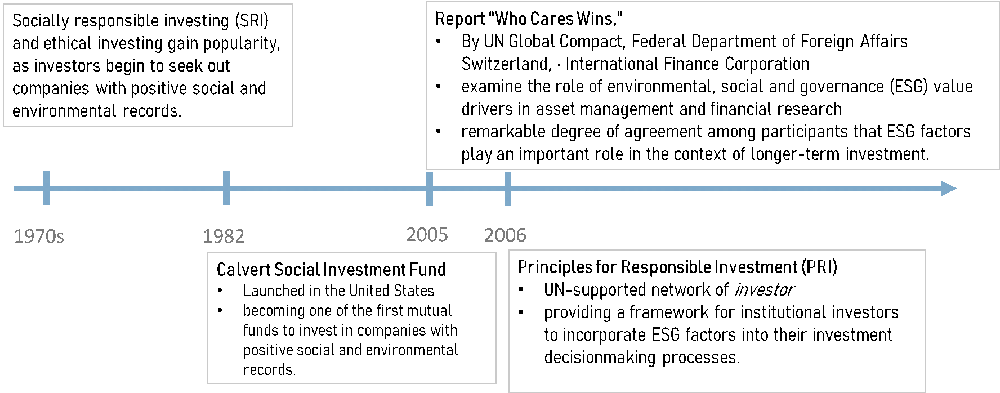
Figure 2: Emergence of the ESG – Key Milestones. Source: own illustration
1.2.4 Attempt of Differentiation of frameworks
The frameworks are closely related and mutually reinforcing. The Paris Climate Conference, where the SDGs were established, has underlined the relevance of the other frameworks and can certainly be seen as a major milestone for the importance of sustainability (see next Chapter 1.3). Nevertheless, in the following an attempt will be made to distinguish the frameworks from each other.
The SDGs are an initiative primarily directed at regulators and governmental institutions. Companies can support peace, the rule of law, and improving institutions, but they are not responsible for doing so. Nevertheless, companies can also make use of this framework and map their activities accordingly. The SDGs show possible starting points for activities to push sustainability, measurability is not (at least not yet) in the focus.
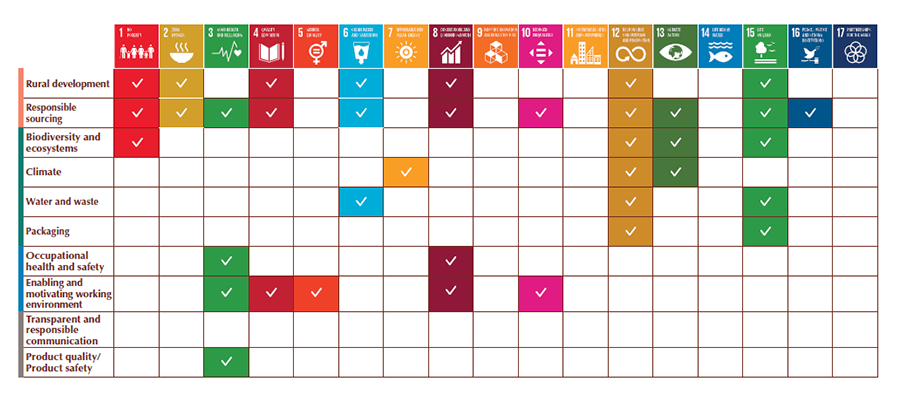
Figure 3: Mapping of Lindt & Sprüngli activities and their impacts and contribution to the 17 SDGs. Source: Lindt & Sprüngli Sustainability Report 2021[13]
CSR, a longer established framework, is one of the strategic management subject areas that came forth as a result of the business being held accountable for its effects on society and the environment. The initiatives taken are usually selective and difficult to verify against the criteria of sustainable development. In the case of CSR, businesses voluntarily assess the efficacy of their initiatives, however implementing programs is prioritized over evaluating their outcomes.
ESG delivers a comprehensive framework for addressing sustainability issues. It focuses on how a given initiative can be assessed and quantified. Using many different scoring ratings, that are based on the ESG Framework, companies can legitimately evaluate their condition and present their ways of managing the supply chain, carbon footprint, or corporate governance to investors and clients.[14] Implementing ESG shows the maturity of the business processes and the willingness to more precise monitoring of its impact. ESG is seen as a measure of sustainability as Companies can properly assess their situation and showcase their methods of controlling.[15]
1.3 UN – Sustainable Development Goals and their connection to climate change
In 2015 the United Nations designed 17 Goals as a call to action to end poverty and protect the planet. These Sustainable Development Goals (SDGs) are meant to ensure that by 2030 everyone around the world can enjoy peace and prosperity. All 17 SDGs are integrated, which means that actions in one area will affect positive outcomes in others as well. Some SDGs focus more on climate action rather than others but ultimately climate action is a big focus of the SDGs.[16]
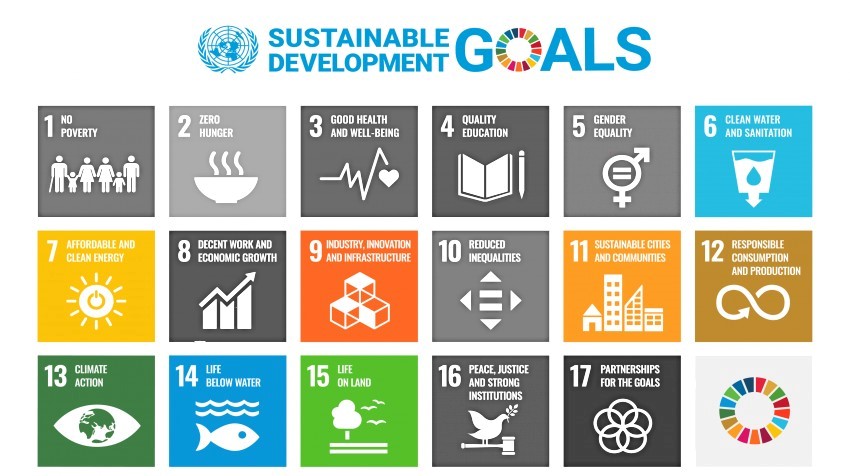
Figure 4: SDGs Overview. Source: United Nations. (n.d.). Sustainable development goals | united nations.
The SDGs 6, 7, 9, 11, 12, 13, 14 and 15 have a more direct link to climate change and thus it is important to have a closer look at them, to fully understand them.
The SDG 6 is focused on ensuring availability and sustainable management of water and sanitation for all. Water is a crucial resource for life, its availability and quality are vital for ecosystems, agriculture, industry and human well-being. Climate change is affecting the water cycle, resulting in more frequent and severe floods and droughts, among other changes. These effects can impact access to clean water and sanitation, exacerbating existing water scarcity and pollution problems. This goal includes targets for increasing water-use efficiency, reducing water pollution, protecting and restoring water-related ecosystems, and improving water management. Additionally, taking action to reduce greenhouse gas emissions and adapt to the impacts of climate change can help achieve SDG 6.[17]
The SDG 7 is to “ensure access to affordable, reliable, sustainable and modern energy for all”. The impact of this Goal on climate change is important to understand. The production and consumption of energy are major drivers of greenhouse gas emissions, which contribute to climate change. The use of fossil fuels, which are the primary source of energy for most of the world’s population, leads to significant emissions of carbon dioxide and other greenhouse gases. One of the targets under this goal is to “increase substantially the share of renewable energy in the global energy mix”. This target aims to support the transition to a low-carbon, renewable energy system, which is an important part of addressing climate change.[18]
The SDG 9 is to “build resilient infrastructure, promote inclusive and sustainable industrialization and foster innovation.” One of the targets under this goal is to “significantly reduce the number of deaths and illnesses from hazardous chemicals and air, water and soil pollution and contamination.” This target aims to improve environmental quality and reduce the negative impacts of pollution on human health, which can be impacted by climate change. Economic growth and development, if not managed sustainably, can lead to increased greenhouse gas emissions and other environmental impacts that aggravate climate change. Therefore, the development of resilient infrastructure and sustainable industrialization can increase the ability of communities to adapt to the impacts of climate change.[19]
The SDG 11 is to “make cities and human settlements inclusive, safe, resilient and sustainable”. One of the targets under this goal is to “strengthen efforts to reduce the adverse per capita environmental impact of cities, including by paying special attention to air quality and municipal and other waste management”. This target aims to support the development of sustainable, low-carbon cities, which can help to reduce greenhouse gas emissions and increase the ability of communities to adapt to the impacts of climate change. Additionally, making cities more resilient to the impacts of climate change can help to protect the health and well-being of urban residents.[20]
The SDG 12 responsible consumption and production states that it is needed to reduce ecological footprint by changing the way we produce and consume goods and resources. It is important to encourage industries, businesses and consumers to recycle and reduce waste. One of the targets under this goal is to “by 2030, substantially reduce waste generation through prevention, reduction, recycling and reuse.” This target aims to support the transition to a circular economy, which can help to reduce greenhouse gas emissions and increase the efficiency of resource use. Additionally, reducing waste can help to decrease the negative impacts of pollution on human health and the environment, which can be impacted by climate change.[21]
The SDG 13 climate action states that greenhouse gas emissions are more than 50% higher than in 1990. Global warming threatens irreversible consequences if neglected and is already causing long lasting changes to our climate system. Goal 13 of the UN SDGs is to “take urgent action to combat climate change and its impacts”.[22] This goal includes several targets that specifically address climate action, which will be discussed further in the chapter 1.3.1.
The SDG 14 life below water states how we manage vital resource is essential for humanity and to counterbalance the effect of climate change. The ocean absorbs 30% of the carbon dioxide produced by humans, which caused a 26% rise in ocean acidification since the beginning of industrial revolution. An average of 13.000 pieces of plastic litter found on every square km of the ocean. Goal 14 of the UN SDGs is to “conserve and sustainably use the oceans, seas and marine resources for sustainable development.” One of the targets under this goal is to “by 2025, prevent and significantly reduce marine pollution of all kinds, in particular from land-based activities, including marine debris and nutrient pollution.” This target aims to reduce pollution in the oceans, which can be impacted by climate change. Additionally, conserving and sustainably using marine resources can help to support the development of low-carbon, climate-resilient economies.[23]
The SDG 15 life on land states that planet life provides 80% of the human diet and rely on agriculture as an important economic resource. Forests provide vital habitats for millions of species and are important sources for clean air and water, they are crucial to combat climate change. Every year 13 million hectares of forests are lost. One of the targets under this goal is to “by 2020, promote the implementation of sustainable management of all types of forests, halt deforestation, restore degraded forests and substantially increase afforestation and reforestation globally.” This target aims to support the conservation and sustainable management of forests, which can help to reduce greenhouse gas emissions and increase the ability of ecosystems to adapt to the impacts of climate change. Additionally, protecting and restoring terrestrial ecosystems can help to build the resilience of communities to the impacts of climate change.[24]
1.3.1 Mapping the SDG to ESG
As already discussed above ESG is a much more defined term, based on many regulations and using data from inside and outside the organization. The three focused dimensions: environment, social, and governance can be matched to SDGs.
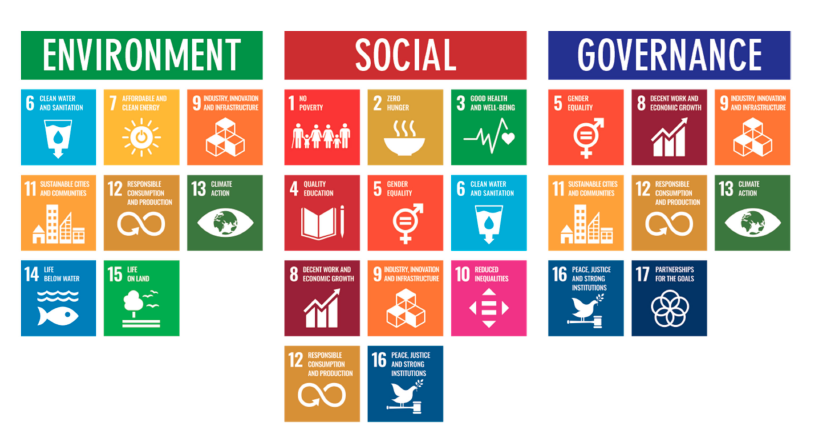
Figure 5: Mapping SDGs to ESG. Source: Rupini, D. (n.d.). Berenberg.de. Retrieved February 18, 2023, from https://www.berenberg.de/fileadmin/web/asset_management/news/esg-news/SDG_understanding_SDGs_in_sustainable_investing.pdf
This mapping shows that the two concepts can complement each other. In this sense, the SDGs can represent possible fields of action for the three dimensions of the ESG concept without having to meet the requirements of measurability and comparability. Breaking down the Dimensions of ESG to the less abstract SDGs, can help in the search for possible areas of action also in terms of potential business ideas.
1.3.2 Detailed consideration of the SDG 13 Climate Action
1.3.2.1 Climate Action and the targets
The SDG 13 as previously mentioned is a Goal defined to “take urgent action to combat climate change and its impacts”. SDG 13 focuses on the change of climate which is attributed directly or indirectly to human activity. Climate change refers to long-term shifts in temperatures and weather patterns and can affect our health, the ability to grow food, housing, safety and the work environment. The main cause of climate change is burning fossil fuels such as oil, gas and coal. When burnt, fossil fuels release carbon dioxide into the air, causing the planet to heat up. Therefore, the effects are already visible and it is important to act now. Climate change poses a real and undeniable threat to our entire civilization. It is important to raise awareness of the problem and everyone can contribute to it. Different measures can be done in different areas but above all it is important to reduce carbon dioxide which is caused by burning fossil fuels. The SDG 13 defines five targets to create action to combat climate change[25]:
- Strengthen resilience and adaptive capacity to climate-related hazards and natural disasters in all countries.
- Integrate climate change measures into national policies, strategies and planning.
- Improve education, awareness-raising and human and institutional capacity on climate change mitigation, adaptation, impact reduction and early warning.
- Implement the commitment undertaken by developed-country parties to the United Nations Framework Convention on Climate Change to a goal of mobilizing jointly $100 billion annually by 2020 from all sources to address the needs of developing countries in the context of meaningful mitigation actions and transparency on implementation and fully operationalize the Green Climate Fund through its capitalization as soon as possible.
- Promote mechanisms for raising capacity for effective climate change-related planning and management in least developed countries and small island developing States, including focusing on women, youth and local and marginalized communities.
1.3.2.2 Climate change mitigation vs. Climate change adaptation
Since climate change is already occurring and some effects of it are inevitable and irreversible, it is important to define and differentiate between the terms climate change mitigation and adaptation. Given that they represent two distinct strategies for tackling the effects of climate change, mitigation and adaptation of climate change are concepts that must be distinguished.
Climate change mitigation refers to measures taken to lower the cause or severity of the problem, which means avoiding and reducing emissions of heat-trapping greenhouse gases into the atmosphere to prevent the planet from warming to more extreme temperatures.
Climate change adaptation means altering our behaviour, systems and ways of life to protect us from the impacts of climate change. The objective is to lessen our exposure to the damaging consequences of climate change such as sea walls to protect against rising sea levels. Additionally, it includes utilizing any favorable chances brought about by climate change.[26]
The challenges brought on by climate change require both adaptation and mitigation. While adaptation is required to deal with repercussions that are presently occurring or are anticipated in the future, mitigation is required to lessen the severity of the issue. Individuals and organizations can take focused steps to effectively address the effects of climate change by being aware of the differences between the two.
1.4 The Paris Agreement as a milestone for climate change
The Paris Agreement is a part of the United Nations Framework Convention on Climate Change (UNFCCC). It is a legally binding international treaty on climate change adopted by 196 Parties at the 21st Conference of the Parties of the United Nations Framework Convention on Climate Change (COP21) in Paris, on December 12th 2015. The agreement is a significant milestone in the global effort to address climate change, and it provides a framework for countries to work together to reduce emissions and limit global warming.
The objective of the Paris Agreement is to limit the global temperature increase to well below 2 degrees Celsius above pre-industrial levels and pursue efforts to limit the temperature increase to 1.5 degrees Celsius. To achieve this goal, the Paris Agreement aims to significantly reduce global greenhouse gas emissions by “peaking” emissions as soon as possible and achieving a balance between sources and sinks of greenhouse gases in the second half of the century. Each nation is required to submit an updated Nationally Determined Contribution (NDC) by 2020, also known as a national climate action plan. The countries’ commitment will be reviewed in a global stocktake every five years. It also stresses, that developed countries should take the lead in giving financial support to developing countries to help them reduce their emissions and adapt to the impacts of climate change. The agreement recognizes the vulnerability of developing countries to the impacts of climate change and seeks to support them in their efforts to address this global challenge.
The Progress of the Paris Agreement will be tracked through the enhanced transparency framework (ETF), which was established by the countries. With the use of this ETF, starting 2024, countries will be be required to report transparently on their progress in addressing climate change through reduction, adaptation, and support efforts. The data obtained by the ETF will be incorporated into the global stocktake, which will evaluate the overall progress in achieving the long-term climate goals. This will result in suggestions for countries to make more ambitious goals for the following round.[27]
1.5 The EU Green Deal
The Europe Comission announced the EU Green Deal on the 11th of December 2019. The EU Green Deal’s purpose is to transform the EU into the first climate neutral continent by 2050. The European Green Deal therefore aims to make a transition into a modern, resource-efficient and competitive economy that emits no net greenhouse gases by 2050, decouples its growth from resource use and leaves no one, person or region, in the lurch. The EU Comission sets the goal of reducing greenhouse gas emissions by at least 55% as well as 3 billion additional trees by 2030 and a path towards climate neutrality by 2050.[28]
Over the last year the European commission has been working to achieve:
- a just and inclusive transition
- clean, affordable and secure energy supply
- a modernized industry
- clean and circular economy
- the protection of biodiversity
- sustainable resilient and smart mobility
- fair and healthy food system
1.6 Terminology related to Sustainable Entrepreneurship
1.6.1 Environmental
The ecological definition of environmental: all external conditions such as air, water, minerals and other organisms that surround and influence a particular organism, often specifically in relation to human interaction with these conditions.[29]
1.6.2 Ecopreneurship
According to Gerald A. Gunderson in his Book Encyclopedia of Corporate Social Responsibility “Ecopreneurship is deliberate human innovation to expand the supply of natural resources and improve environmental quality”.[30]
Environmental entrepreneurship, often known as “ecopreneurship,” is the practice of applying entrepreneurship to the creation of businesses that address environmental issues or operate sustainably.[31]
1.6.3 Zero waste
1.6.3.1 Definition of Zero Waste
According to the Zero Waste International Alliance zero waste is “the conservation of all resources by means of responsible production, consumption, reuse, and recovery of products, packaging, and materials without burning and with no discharges to land, water, or air that threaten the environment or human health”.[32]
According to Zero Waste Germany e.V. the term Zero Waste means “zero garbage, zero waste” and refers to a philosophy that aims to eliminate the causes of waste and waste in human behavior. The Zero Waste approach aims to promote a change in thinking in favor of sustainable, conscious use of our planetary resources, in order to bring our production and consumption behavior back into harmony with the balance of nature in this way. Zero Waste is not intended as an immediate rule, but rather as a long-term guiding principle to be strived for in a continuous process.[33]
1.6.3.2 The goal of zero waste
Zero waste is a philosophy and approach that seeks to eliminate waste by redesigning the entire lifecycle of a product or system. It aims to reduce, reuse, and recycle resources, so that nothing goes to waste.
The goal of zero waste is to create a closed loop system, where resources are continuously cycled back into the production process. This includes reducing the use of single-use and disposable items, encouraging the use of durable and reusable products, and ensuring that any waste that is generated is repurposed or recycled. To sum it up, the goal is to not send rubbish to landfills.[34]
1.6.3.3 Basis to achieve the goal of zero waste
To follow the Zero Waste Approach, one can apply so-called 5R principles of the Zero Waste hierarchy which are shown in the following figure:

| Figure 6: The 5R Principles. Source: Johnson, B., Zero Waste Home (2013) |
The terms in the figure mean the following in detail[35]:
- Refuse: Do without everything that is not needed
Rethink: Rethink purchasing decisions and your consumption behaviour
- Reduce: Reduce consumption
- Reuse: Focus on recycling
- Recycle: Recycle only what is necessary
Repair: make sure when you buy them that you can repair them if necessary
- Rot: Compost waste that cannot be recycled
1.6.4 Zero emissions / Net Zero Carbon Emissions / Climate Neutrality
Climate neutrality exists when a carbon footprint has been measured, reduced and offset. The result is a balance between emissions caused on the one hand and emissions avoided on the other.
There are three categories of emissions that need to be accounted for when achieving carbon neutrality[36]:
Scope 1: direct emissions of a company, e.g. the CO2 emitted by a company’s vehicle fleet.
Scope 2: indirect emissions, e.g. the energy supply of the company building, which already causes emissions when it is produced.
Scope 3: indirect emissions that are not within the direct sphere of influence of the company, such as the supply chain.
1.6.5 Circular economy
According to the European Parliament “the circular economy is a model of production and consumption, which involves sharing, leasing, reusing, repairing, refurbishing and recycling existing materials and products as long as possible. In this way, the life cycle of products is extended”.[37]
The traditional linear economic model is based on a ‘take-make-consume-throwaway’ pattern, but the circular economy in practice wants to reduce waste to a minimum. As a product reaches the end of its useful life, its components are whenever possible preserved within the economy. They can be productively used repeatedly, thus adding more value and increasing the raw materials supply[38].
Reduce, ReUse and Recycle (also known as 3-R Strategy) is the name of this 7-part strategy that is an integral part of the circular economy concept.
7 steps to implement circular economy:
- Regeneration: Restoring ecosystems
- Sharing: to extend product life (e.g. through second-hand shops)
- Efficiency and performance optimisation of all products: related to lifespan and compatibility.
- Recycling: parts, materials and products undergo a re-cycling and upcycling process.
- Dematerialisation: reduction of unnecessary items
- principle of exchange economy (e.g. collection of old clothes or exchange of old, ecologically inefficient manufacturing mechanisms)
- repairing instead of throwing away: Abolish the mindset that restoration is more cost-intensive than a new acquisition.
The 3 actors using this 7-part strategy are Businesses, governments and the civil society.[39]
2. Standards and strategies
2.1 EU Taxonomy
Since 2022, the EU Taxonomy Regulation has been a key component of the EU’s Green Deal.
The EU Taxonomy regulation was adopted by the European Commission in 2020. It is part of the “Action Plan for Financing Sustainable Growth” presented by the EU Commission in March 2018. This is intended to direct capital flows into environmentally sustainable economic activities.
It is intended to drive the reduction of environmentally harmful greenhouse gases: In order to achieve a significant reduction in CO2 emissions, a climate-friendly transformation of all economic sectors is necessary. The EU taxonomy is intended to steer more private investment into this endeavor. This will make sustainability a criterion for risk management in the financial sector.
The taxonomy applies to all sectors of the economy. It establishes a set of rules for climate and environmentally friendly activities and investments and has identified six climate and environmental protection targets for this purpose[40]:
- combat climate change / CO2 reduction
- adapt to climate change
- sustainable use and protection of water and ocean resources
- transition to a circular economy
- pollution prevention and control
- protection and restoration of biodiversity and ecosystems
For the first two targets mentioned above, “CO2 reduction” and “adapt to climate change,” new reporting requirements for companies have already been in place since January 1, 2022: They must prepare reports on their “Corporate Social Responsibility” (CSR) to demonstrate their social responsibility for sustainable business.
Since January 1, 2022, banks have been required to disclose their “taxonomy eligibility”, they have to indicate for what proportion of the assets they manage there are taxonomy criteria at all. From 2024, they will then be required to report annually what percentage of their own financing complies with the taxonomy’s sustainability requirements (“Green Asset Ratio”).
Since the beginning of 2022, capital market-oriented companies with more than 500 employees – for example stock corporations – have to provide information on whether and to what extent taxonomy sustainability criteria have been defined for their economic activities. From 2023, they will then have to disclose their “taxonomy compliance”, which means they have to indicate whether the criteria are met. These reporting requirements will in all likelihood be extended, so that in the future many more companies – including an increasing number of SMEs – will probably have to report directly on their sustainability and thus also their taxonomy compliance.[41]
2.2 International standards for sustainable business practices
2.2.1 Extended producer responsibility (EPR)
Extended Producer Responsibility (EPR) is a key concept for ‘closing the loop’ in the packaging value chain.
The EPR Toolbox developed by the PREVENT Waste Alliance is a collection of internationally relevant knowledge on the topic of EPR for packaging. Its aim is to promote knowledge exchange and enhance development of EPR systems worldwide. The EPR Toolbox contains detailed training materials on EPR, practical country examples and a set of FAQs. [42]
2.2.2 ISO 14000 standard for environmental management certification
ISO 14000 is a family of standards related to environmental management that exists to help organizations (a) minimize how their operations (processes, etc.) negatively affect the environment (i.e. cause adverse changes to air, water, or land); (b) comply with applicable laws, regulations, and other environmentally oriented requirements; and (c) continually improve in the above.
ISO 14000 is similar to ISO 9000 quality management in that both pertain to the process of how a product is produced, rather than to the product itself. As with ISO 9001, certification is performed by third-party organizations rather than being awarded by ISO directly. The ISO 19011 and ISO 17021 audit standards apply when audits are being performed.[43]
2.2.3 ISO 14001 environmental management system
The requirements of ISO 14001 are an integral part of the European Union’s Eco-Management and Audit Scheme (EMAS). EMAS’s structure and material are more demanding, mainly concerning performance improvement, legal compliance, and reporting duties. The current version of ISO 14001 is ISO 14001:2015, which was published in September 2015.[44]
2.2.4 ISO 14040 Life Cycle Assessment (LCA)
Technique for assessing the environmental aspects and potential impacts associated with a product throughout its life (i.e. cradle to grave), by[45]
- compiling an inventory of relevant inputs and outputs of a product system
- evaluating the potential environmental impacts associated with those inputs and outputs
- interpreting the results of the inventory analysis and impact assessment phases in relation to the objectives of the study
LCA can assist in[46]
- identifying opportunities to improve the environmental aspects of products at various points in their life cycle
- decision-making in industry, governmental or non-governmental organizations (e.g. strategic planning, priority setting, product or process design or redesign)
- selection of relevant indicators of environmental performance, including measurement techniques and
- marketing (e.g. an environmental claim, ecolabelling scheme or environmental product declaration)
LCA is still at an early stage of development therefore, it is important that the results of LCA be interpreted and applied appropriately. When applied within small- and medium-sized enterprises, LCA maintains its technical credibility while providing flexibility, practicality and cost effectiveness. LCA typically does not address the economic or social aspects of a product. An LCA usually proceeds according to the following scheme[47]:
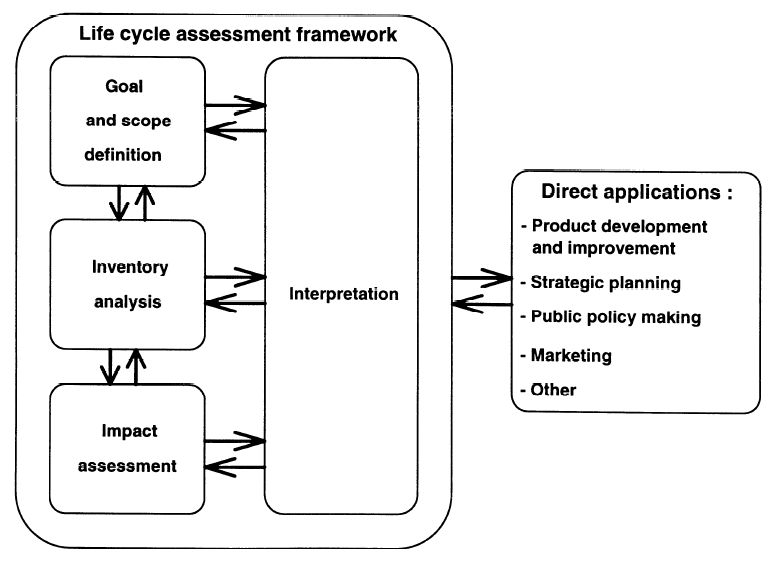
Figure 7: Phases of an LCA. Source: ISO 14040:1997E
2.2.4.1 LCA limitations
The LCA method is demanding and subject to some limitations[48]:
- The nature of choices and assumptions made in LCA (e.g. system boundary setting, selection of data sources and impact categories) may be subjective
- Models used for inventory analysis or to assess environmental impacts are limited by their assumptions and may not be available for all potential impacts or applications.
- Results of LCA studies focused on global and regional issues may not be appropriate for local applications, i.e. local conditions might not be adequately represented by regional or global conditions
- The accuracy of LCA studies may be limited by accessibility or availability of relevant data, or by data quality, e.g. gaps, types of data, aggregation, average, site-specific
- The lack of spatial and temporal dimensions in the inventory data used for impact assessment introduces uncertainty in impact results. This uncertainty varies with the spatial and temporal characteristics of each impact category
Generally, the information developed in an LCA study should be used as part of a much more comprehensive decision process or used to understand the broad or general trade-offs
Comparing results of different LCA studies is only possible if the assumptions and context of each study are the same
These assumptions should also be explicitly stated for reasons of transparency
2.2.4.2 Success factors of LCA
There are several success factors to consider when applying LCA[49]:
- LCA studies should systematically and adequately address the environmental aspects of product systems, from raw material acquisition to final disposal
- The depth of detail and time frame of an LCA study may vary to a large extent, depending on the definition of goal and scope
- The scope, assumptions, description of data quality, methodologies and output of LCA studies should be transparent. LCA studies should discuss and document the data sources, and be clearly and appropriately communicated
- Provisions should be made, depending on the intended application of the LCA study, to respect confidentiality and proprietary matters
- LCA methodology should be amenable to the inclusion of new scientific findings and improvements in the state-of-the-art of the technology
- Specific requirements are applied to LCA studies which are used to make a comparative assertion that is disclosed to the public
2.2.4.3 Reporting of LCA
There are a few criteria that must be fulfilled when reporting the LCA[50]:
- The results of the LCA shall be fairly, completely and accurately reported to the intended audience
- The type and format of the report shall be defined in the scope phase of the study
- The results, data, methods, assumptions and limitations shall be transparent and presented in sufficient detail to allow the reader to comprehend the complexities and trade-offs inherent in the LCA study
- The report shall also allow the results and interpretation to be used in a manner consistent with the goals of the study
The LCA will be critically reviewed regarding the following requirements[51]:
- the methods used to carry out the LCA are consistent with this International Standard
- the methods used to carry out the LCA are scientifically and technically valid
- the data used are appropriate and reasonable in relation to the goal of the study
- the interpretations reflect the limitations identified and the goal of the study
- the study report is transparent and consistent
2.2.5 ISO 14044 Life Cycle Inventory Analysis (LCI)
The life cycle inventory analysis phase (LCI phase) is the second phase of LCA. It is an inventory of input/output data with regard to the system being studied. It involves the collection of the data neces- sary to meet the goals of the defined study.[52]
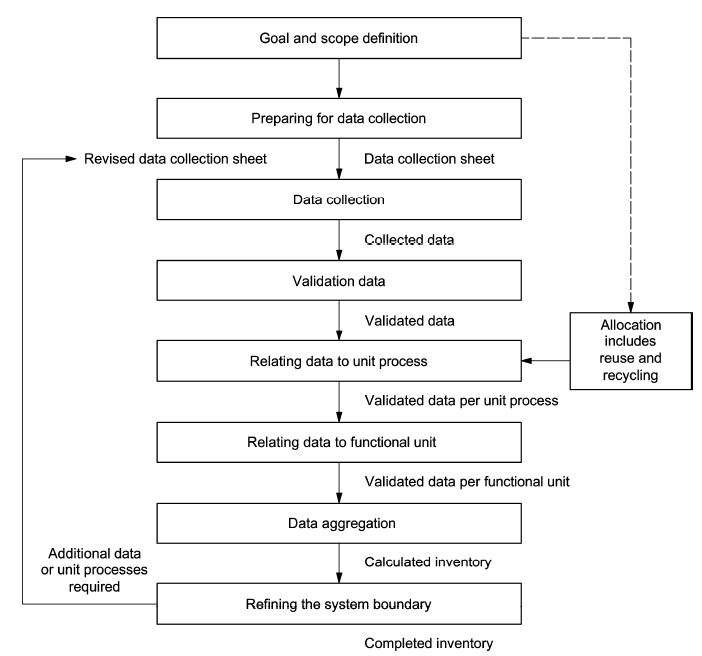
Figure 8: Procedures for inventory analysis. Source: ISO 14040:1997E
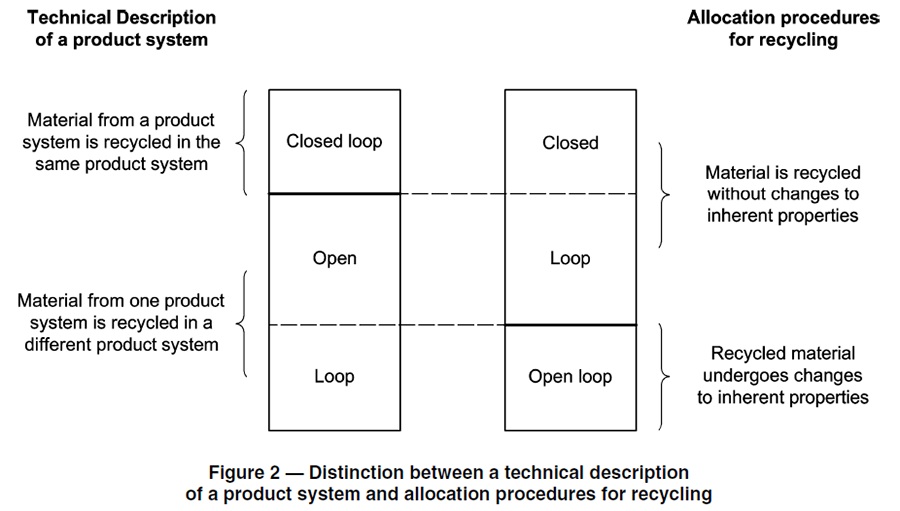
Figure 9: Distinction between a technical description of a product system and allocation procedures for recycling. Source: ISO 14040:1997E
2.2.5.1 Life Cycle Impact Assessment (LCIA) à a relative approach based on a functional unit
The LCIA phase shall be coordinated with other phases of the LCA to take into account the following possible omissions and sources of uncertainty[53]:
- whether the quality of the LCI data and results is sufficient to conduct the LCIA in accordance with the study goal and scope definition
- whether the system boundary and data cut-off decisions have been sufficiently reviewed to ensure the availability of LCI results necessary to calculate indicator results for the LCIA
- whether the environmental relevance of the LCIA results is decreased due to the LCI functional unit calculation, system wide averaging, aggregation and allocation
The LCIA phase shall include the following mandatory elements:
- selection of impact categories, category indicators and characterization models
- assignment of LCI results to the selected impact categories (classification)
- calculation of category indicator results (characterization)
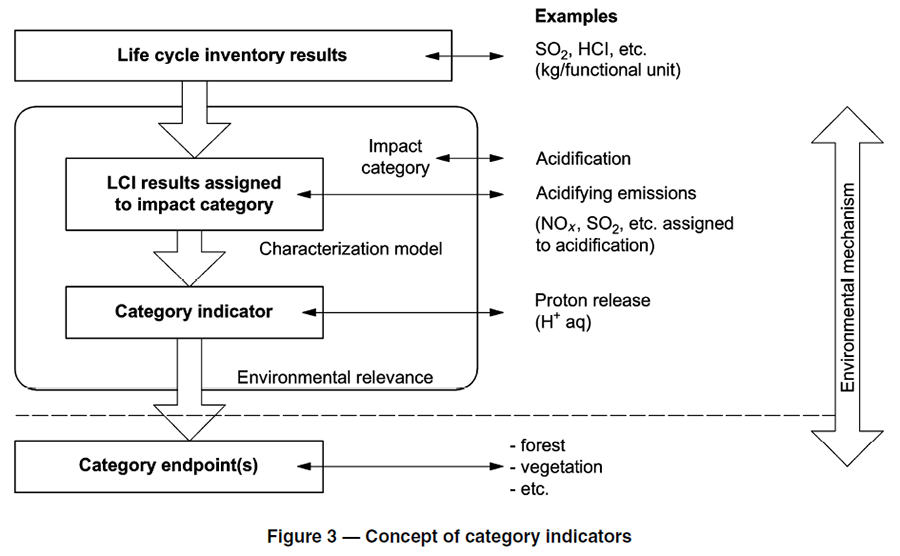
Figure 10: Concept of category indicators. Source: ISO 14044:2006
2.2.5.2 Life Cycle Interpretation
The life cycle interpretation phase of an LCA or an LCI study comprises several elements as depicted in Figure 4, as follows[54]:
- identification of the significant issues based on the results of the LCI and LCIA phases of LCA
- an evaluation that considers completeness, sensitivity and consistency checks
- shall consider the appropriateness of the definitions of the system functions, the functional unit and system boundary
- conclusions, limitations, and recommendations
The goal and scope definition and interpretation phases of life cycle assessment frame the study, whereas the other phases of LCA (LCI and LCIA) produce information on the product system.
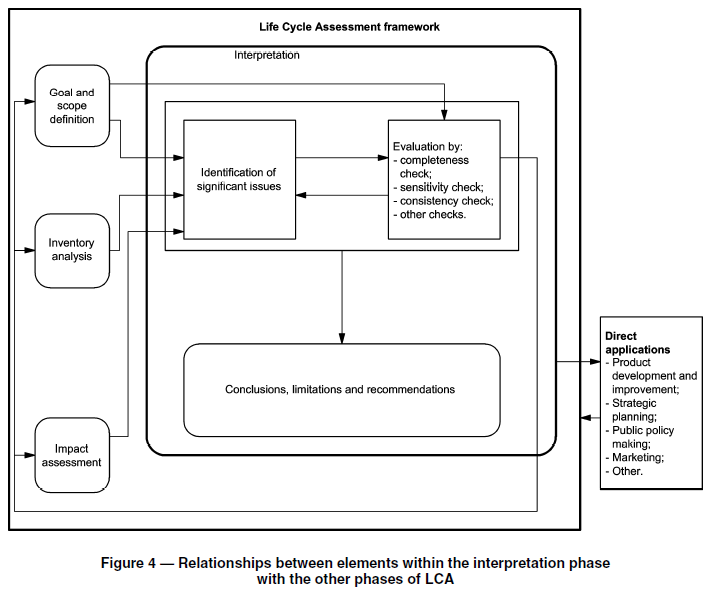
Figure 11: Relationships between elements within the interpretation phase with the other phases of LCA. Source: ISO 14044:2006
2.2.6 ISO 26000 standard as a guideline for social responsibility
ISO 26000:2010 Guidance on social responsibility is an international standard providing guidelines for social responsibility (SR, often CSR – corporate social responsibility). It was released by the International Organization for Standardization on 1 November 2010 and its goal is to contribute to global sustainable development by encouraging business and other organizations to practice social responsibility to improve their impacts on their workers, their natural environments and their communities[55].
The structure of ISO 26000 is as follows:
- Scope
- Terms and definitions
- Understanding social responsibility
- Principles of social responsibility
- Recognizing social responsibility and engaging stakeholders
- Guidance on social responsibility core subjects
- Guidance on integrating social responsibility throughout an organization.
ISO 26000 offers guidance on socially responsible behavior and possible actions. There are three ways in which it is different from the more widespread standards designed for companies to use to meet particular requirements for activities such as manufacturing, managing, accounting and reporting:
- ISO 26000 is a voluntary guidance standard: it does not contain requirements such as those used when a standard is offered for “certification”. There is a certain learning curve associated with using ISO 26000, because there is no specific external reward – certification – explicitly tied to ISO 26000. ISO recommends that users say, for example, that they have “used ISO 26000 as a guide to integrate social responsibility into our values and practices”.
- ISO 26000 is designed for use by all organizations, not only businesses and corporations. Organizations such as hospitals and schools, charities (not-for-profits), etc. are also included. ISO 26000 makes particular efforts to show that its flexibility means that it can be applied by small businesses and other groups as well. So far,[when?] many of the earliest users of ISO 26000 have been multi-national corporations, especially those based in Europe, and East Asia, particularly Japan.
- ISO 26000 was developed through a multi-stakeholder process, meeting in eight Working Group Plenary Sessions between 2005 and 2010, with additional committee meetings and consultations on e-mail throughout the five-year process. Approximately five hundred delegates participated in this process, drawn from six stakeholder groups: Industry, Government, NGO (non-governmental organization), Labour, Consumer, and SSRO (Service, Support, Research and Others – primarily academics and consultants). Leadership of various task groups and committees was “twinned” between “developing” and “developed” countries, to ensure viewpoints from different economic and cultural contexts. Since ISO operates on a parliamentary procedure form based on consensus, the final agreed-on standard was the result of deliberation and negotiations; no one group was able to block it, but also no one group was able to achieve its objectives when others strongly disagreed. The goal was to make ISO 26000 accessible and usable by all organizations, in different countries, precisely because it reflects the goals and concerns of each and all of the stakeholder groups in its final compromise form.
2.3 Strategies on Climate Change
2.3.1 McKinsey on Climate Change (2020)
Physical climate risk has seven characteristics:
- Physical climate risks are generally increasing across the globe, even though some countries may find some benefits (such as increased agricultural yields in Canada, Russia, and parts of northern Europe). The increased physical risk would also increase socioeconomic risk.
- Climate hazards manifest locally. There are significant variations between countries and even within countries. The direct effects of physical climate risk must be understood in the context of a geographically defined area.
- The coming physical climate risk is ever-changing and nonstationary. Therefore, decision making based on experience may prove unreliable (e. g. infrastructure design may need to be rethought or homeowners and banks may need to adjust assumptions about long-term mortgages).
- Physiological, human-made, and ecological systems have evolved or been optimized over time to withstand certain thresholds. Those thresholds are now being threatened. If or when they are breached, the impact won’t be incremental—the systems may falter, break down, or stop working altogether (e. g. crops grown for a mild climate will wither at higher temperatures).
- Climate change can have knock-on effects across regions and sectors, through interconnected socioeconomic and financial systems (e. g. a flooding might not only damage housing but also raise insurance costs, lower property values, and reduce property-tax revenues). Supply chains are particularly vulnerable systems since they prize efficiency over resilience. They might quickly grind to a halt if critical production hubs are affected by intensifying hazards.
- The poorest communities and populations of the world are the most vulnerable.
- Our society hasn’t confronted a threat like climate change, and we are unprepared. While companies and communities are already adapting, the pace and scale of adaptation must accelerate. This acceleration may well entail rising costs and tough choices, as well as coordinated action across multiple stakeholders.
Heat waves in India: risks and adaptation options
- By 2050, between 310 million and 480 million living in urban areas have a nonzero probability of heat waves occurring > outdoor workers (75 percent of the labor force, 50 percent of India’s GDP) will need to take breaks to avoid heatstroke; their bodies will protectively fatigue to avoid overheating; by 2030, diminished labor productivity could reduce GDP by between 2.5 and 4.5 percent > ways to adapt: increased access to air-conditioning; early-warning systems; cooling shelters; working hours for outdoor personnel could be shifted; cities could implement heat-management efforts; extreme, coordinated movement of people and capital from high-risk areas could be organized > costly
Floodings: risks and adaptation options
- Rising sea levels, increased tidal flooding, and more severe storm surges from hurricanes; in Florida in 2050, a once-in-100-years hurricane might cause $75 billion worth of damage to Florida real estate, up from $35 billion today; Bristol, England, a once-in-200-years flood in 2065 could cause ≤$3 billion in damage; in Ho Chi Minh City, Vietnam, a once-in-100-years flood in 2050 could wreak ~$10 billion in damage > prices of exposed homes could drop, mortgage rates could rise, more homeowners may strategically choose to default, and property-tax revenue could drop 15–30% in directly affected countries > improving the resilience of existing structures; installing new green infrastructure; building seawalls
Changing patterns of precipitation in Africa: risks and adaptation options
- African farmers are generally more vulnerable to higher temperatures, fluctuations in rainfall, and variable yields than farmers in developed countries, who can usually more easily secure crop insurance, adjust what they plant, irrigate their fields, or apply crop protection chemicals and fertilizers (e. g. one third of GDP for Ethiopia and one fifth of sub-Sahara Africa’s economic output depend on crops) > higher price volatility, for both farmers and consumers > better and more localized planning and financial mobilization will be key; modernizing Africa’s agriculture; better roads can help connect markets, which would help farmers sell their crops at fair prices; improvements in the functioning of seed production systems would provide farmers with new varieties of seed that are suited to new conditions; upgraded crop-storage facilities would prevent spoilage and food waste; wider access to agricultural financial instruments, such as crop insurance, would enable individual farmers and households to better manage climate-related risks;
An effective response
- Integrate climate risk into decision making: For companies, this will mean taking climate considerations into account when looking at capital allocation, development of products or services, and supply-chain management, for example. Large capital projects would be evaluated in a way that reflects the increased probability of climate hazards at their location: How will that probability change over time? What are the possible changes in cost of capital for exposed assets? How will climate risk affect the broader market context and other implicit assumptions in the investment case? Cities will have to ask similar questions for urban-planning decisions.
One of the biggest challenges from climate risk will be rethinking the current models we use to quantify risk. These range from financial models used to make capital-allocation decisions to engineering models used to design structures. There is some uncertainty associated with a methodology that leverages global and regional climate models, makes underlying assumptions on emission paths, and seeks to translate climate hazards to potential physical and financial damage. But exploring new ways to quantify climate risk is not the highest “model risk.” Continued reliance on current models based on stable historical climate and economic data may be even riskier.
Indeed, current models have at least three potential flaws. First, they lack geographic granularity, at a time when companies need to know how their key locations—and those of their suppliers—are exposed to different forms of climate threat. Second, they don’t consider that the climate is constantly changing, a critical factor in determining such things as how resilient to make new factories, what tolerance levels to employ in new infrastructure, and how to design urban areas. And third, they are subject to potential sample bias, since decision makers are accustomed to trusting their own experience as they make decisions about the future.
- Accelerate the pace and scale of adaptation: The pace and scale of adaptation will likely need to increase significantly. Key measures include protecting people and assets, building resilience, reducing exposure, and ensuring that appropriate insurance and financing are in place.[56]
2.3.2 Getting Ahead of the Curve: Corporate Strategies that Address Climate Change
This report compiles the experience and best practices of large corporations that have developed and implemented strategies to address climate change. Based on a 31-company survey, six in-depth case studies, a review of the literature, and experience gained by the Pew Center in working with companies in its Business Environmental Leadership Council (BELC), the report describes the development and implementation of climate-related strategies. It is primarily a “how to” manual for other companies interested in developing similar strategies. But the report will also be of value to investors and analysts in evaluating the effectiveness of company strategies for managing climate risk and capturing climate-related competitive advantage. Finally, it will offer policymakers insight into corporate views on greenhouse gas (GHG) regulation, government assistance for technology advancement, and other policy issues. Although the report focuses primarily on U.S.-based multinationals, it considers the global context of climate change and related market transformation.[57]
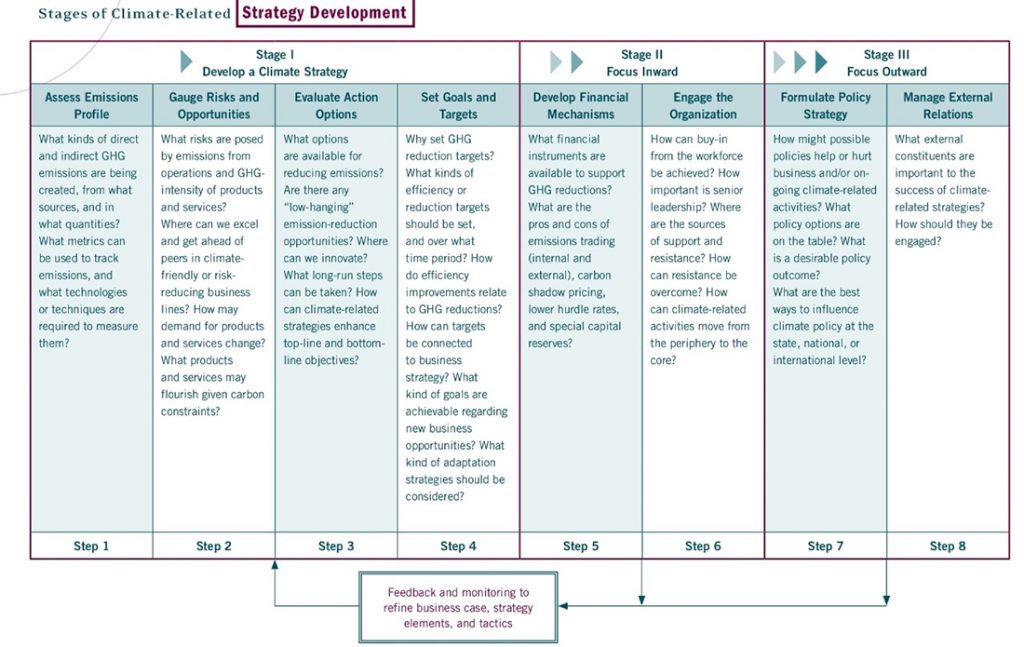
Figure 12: Stages of Climate Related Strategy Development. Source: Getting ahead of the curve: Corporate strategies that address climate change. (2006, October 12). Center for Climate and Energy Solutions.
3. Best Practices
Best practice examples are collected to demonstrate the multitude of sustainable practice actions in the companies. Different businesses use different sustainable business models, there is no formula that fits all. Through the cases studies the reader can see how different sustainability policies are implemented by businesses.
3.1 Ecosia
Ecosia is a free browser extension that plants trees. They use the revenue from searches to plant trees where they are desperately needed. Additionally, they identify environmentally friendly companies for users and give preference to environmentally friendly search results. The trees are seen as the basis for an intact environment, healthy people and a stable economy. It is important to note that Ecosia does not sell user data and do not share it with third parties.[58]
3.2 Everwave GmbH
Everwave focuses on preventing plastic from entering the oceans. They start with the main entry routes, which are the rivers. They use clean-up technologies to efficiently collect garbage and return it to a sustainable cycle. Everwave collects garbage with the help of innovative waste collections boats and river platforms. Rubbish is detected and analyzed in cooperation with the German Institue for Atrificial Intelligence, it gives conclusions about composition and polluter. Their Goal is to raise public awareness of the issue of sustainability with lectures and media appearances, thus to ensure education and attention.[59]
3.3 Babor Beauty Group
Babor’s Green Agenda contains three main topics: CO2, Packaging, and Ingredients. Since 2014 they focus on CO2-neutral production at the headquarters in Aachen through green electricity, photovoltaics and climate-neutral eco natural gas. Climate-neutral corporate carbon footprint and product carbon footprint has been an added focus since 2020. Together with ClimatePartner, Babor has precisely calculated its carbon footprint and offsets all emissions that cannot yet be prevented through its own measures – both in terms of the emissions produced by the company and its employees, and in terms of the company’s products. Babor offsets its CO2 emissions by promoting a wind farm in the Philippines. At the same time, the company supports the global initiative Plastic Bank.
In Haiti, Indonesia and the Philippines, people collect plastic from beaches and thereby improve their income. This plastic is recycled as social plastic so that new products are created from it. With every ton of CO2 offset, Babor simultaneously offsets 10 kg of plastic waste. In the future, Babor wants to focus even more on avoidance instead of compensation. In its new office building, Babor relies on sustainability technology and saves 45 % energy thanks to geothermal energy, a gas-powered combined heat and power plant (CHP), special cooling ceilings and heat exchangers. Their focus are clean Ingredients with the goal that all formulas are free of microplastic particles and environmentally critical synthetic polymers. Resource-critical raw materials are switched to certified goods and alternatives. All new formulations are developed free of microplastics and synthetic polymers. Where it is possible, existing formulations will be converted to alternatives in the course of relaunches by 2023. Where it is necessary, polymers that conserve resources and are good for the environment will be used instead. Only certified palm oil derivatives are used and their consumption is also reduced.[60]
3.4 Ellen MacArthur Foundation
The Ellen MacArthur Foundation works to accelerate the transition to a circular economy. They develop and promote the idea of a circular economy and work with businesses, scientists, policymakers and institutions to mobilise system solutions at scale worldwide. They are a charity committed to creating a circular economy, which is designed to eliminate waste and pollution, circulate products and materials (at their highest value), and regenerate nature. Additionally, they create evidence-based original research on the benefits of a circular economy, and how it can contribute to solving global challenges like climate change and biodiversity loss. They explore the opportunities across stakeholders and sectors, and highlight examples of how circular economy principles are being put into practice today and support organisations and individuals with formal learning opportunities through our circular economy courses, and create resources for teachers and academics.[61]
3.5 Traceless Materials GmbH
Traceless is a circular bioeconomy startup, which engineers advanced biomaterials that integrate into nature’s biological cycle without leaving a trace. They offer a holistically sustainable alternative material to conventional plastics and bioplastics. They designed materials according to the Cradle To Cradle principle. Not only do they help to solve plastic pollution, they also leave a holistically positive footprint on the planet. Traceless’ disruptive potential lies in patent-pending technology, they extract natural biopolymers from agricultural industry residues. So instead of synthetically creating new polymer molecules, they use the ones that nature has already produced.[62]
3.6 reCup Gmbh
RECUP and REBOWL are Germany’s largest reusable system to counteract the immense amount of waste caused by disposable packaging. In return for a deposit, food and drink can be filled into the RECUPs or REBOWLs at cooperating businesses and restaurants and then taken home. Borrowed RECUPs and REBOWLs can then be returned to all partner businesses throughout Germany and the deposit will be refunded. The reusable system is microwaveable, leak-proof, 100% recyclable and BPA-free.[63]
3.7 Haribo
Despite strict guidelines, the sweets manufacturer HARIBO tries to make its packaging as sustainable as possible. The packaging material used is polypropylene, which can be recycled with the appropriate disposal structures. Already 90% of the packaging is recycled. The recovery of used raw materials for closed material cycles is one of the central levers for minimising the consumption of resources – and saving a lot of energy at the same time.[64]
At the main location in Grafschaft in Germany, the company’s own electricity production is being pushed further and further. With photovoltaic systems already installed and more planned, the aim is to achieve a degree of energy self-sufficiency of around 30 per cent. Other locations are also increasingly being equipped with sustainable energy solutions.[65]
3.8 MÁDARA Cosmetics
MÁDARA Cosmetics is a manufacturer of eco-cosmetics and was founded in 2006 by four Latvian women. MÁDARA has transformed into a team of more than 150 professionals. Their take on sustainability is that sustainability leans not only towards the environment, but also people and other living beings. At MÁDARA, sustainability is deeply ingrained in the very consciousness and purpose of the company. It is practiced when we choose suppliers, select ingredients, promote and deliver our products. The times we are living in call for greater responsibility, and we as a company aim to embrace the future by embodying principles that coexist with the environment and society.[66]
3.9 Rimi Baltic
Rimi Baltic is one of the largest retailers in the Baltic States and since 2020 Rimi also has an e-store in all three Baltic Countries. The company employed over 12000 people across the Baltics. Rimi and ICA Gruppen are dedicated to the field of sustainability and continuously provide the required support to continue sustainable development. They reduced CO2 emissions by 83% versus 2006 and from 2021 and are a climate neutral company. 51% of the Rimi private label products plastic packaging is easy to recycle. In 2021 they have reduced food waste by 9% versus 2020. They have donated 2019 tons of food in 2021 and that is 70% more than last year. They have also participated in Future HUB start-up accelerator programs and are working with 3 start-ups now. There are in total 1531 healthy products in Rimi’s range, with a label “Rimi Good for You” and its sales increased by 16% versus 2020. Mental well-being was selected as one of the focus areas in Health Strategy and they decided to invest in it.[67]
3.10 Airbaltic
AirBaltic vision is becoming a sustainable carrier in the EU aviation market, while maintaining a continuous growth path, innovative improvement of passenger experience and developing the Baltic states as one of the key European business centers.[68]
3.11 Omniva
The holding company Omniva in Baltics include the parent company AS Eesti Post, Estonian subsidiary AS Maksekeskus, Lithuanian subsidiary Omniva UAB and Latvian subsidiary Omniva SIA. Their vision states that they want to be the preferred logistics operator providing seamless omnichannel with high commitment and in sustainable way by 2026. They are confident that the service offered by Omniva Latvija is, on its merits, based on the idea of sustainability and challenges faced by the modern world. In general, their services have a positive effect on the economics, environment and society as they promote rational and efficient consumption of resources. At the same time, they are aware that even their services leave a footprint, which they are constantly seeking to reduce in a targeted manner. They are affected by and affect multiple stakeholders (customers, vendors, employees) and the economical processes in a broader context. [69]
3.12 Hyrogas
Hyrogas is a research and engineering company developing technology for the distributed production of energy from renewable sources. This can be biomass or any waste containing carbon. Hyrogas can produce synthetic gas from biogenic or new carbon, or recycle waste and extract this raw material from non-renewable resources. The unique value proposition of Hyrogas is to develop distributed energy systems with zero or negative carbon footprint. “The aim is to develop and bring to market a technology that contributes to both the circular economy and the European Green Deal. We are developing the technology in Latvia, but we see great potential for export,” says Valdis Bisters, the CEO of Hyrogas.[70]
3.13 TerraWaste
The science-intensive startup TerraWaste has developed a technology for recycling waste into a “soup” in the form of an oil product. They are building recycling tech to bring future cities in balance and stop the polution. They want to bring to life a technology that will free the planet from non-recyclable waste and pollution, and will turn it into valuable assets that will bring revenue.[71]
4. Interview results
As a part of this research, several interviews with different companies that operate sustainable or focus on sustainability were conducted. These companies are mainly from Germany, Finland and Latvia and in the following chapters we will look at the main findings of each interview.
4.1 Overlook
Overlook is funded by public money to research their idea and develop it further. Their main focus is on sustainability and offer a free platform to make the topic of sustainability more transparent. How does that work? If a consumer for example wants to purchase something from a company and want to know if they operate sustainably. That information can then be found on their website, on overlook.one. The platform shows a sustainability score on a scale from 1 to 10, which helps in the decision-making process. This means that sustainability becomes tangible, comparable and transparent. The companies can use the feedback and exchange with consumers as well. Right now, the score itself is composed of users’ assessment of the brand, meaning users rate products and share their personal experiences with the overlook community. In the future, they would like to add a more objective score to the ranking – e. g. with certificates like B Corp. The main idea behind it is to create an exchange platform between companies and consumers. It is supposed to help companies get the feedback they need to improve their products and services.
Overlook places importance to climate protection in relation to sustainability, they say climate protection must be given focused attention. Looking at the definition of sustainability, Overlook says that longevity and ensuring the surviving of generations to come is important. Thus, all three dimensions should always be considered as well: ecological, social and economic. They stress that with everything that is going on in the world right now, e.g. inflation, war, etc., people focus more on economic profitability rather than sustainability. There is a lot of research being conducted right now which leads to a lot of changes and consequently, a lot of uncertainty for companies. They face the challenge of finding people with sufficient up-to-date knowledge and then coordinating them. There are not enough incentives, e.g. from politics or business, to use tools for improvement. As the demand increases, there will be more suitable and good opportunities.
4.2 Inform Software GmbH
Inform is one of the oldest software enterprises in Germany, which was found in 1969 by Prof. Zimmermann who gave lectures at the RWTH on the topic of Operations Research. It follows the idea to help companies reduce resources with the aid of mathematical modelling. By modelling a company’s business processes with real life data, they can optimize the use of resources. Nowadays, Inform e.g. optimizes whole turnover processes at airports and all its available resources such as labor, busses, baggage, etc. to be used most efficiently, for delays to be avoided as much as possible and for CO2 emissions to be reduced. They do the same thing at seaports, e. g. Rotterdam or Hamburg where huge, international container ships are being (re- or un-)loaded. They also help companies manage their inventory.
Inform states that if you look at it as a whole, one can see that there are three levers to pull. First of all, emissions need to be reduced. Secondly, – this is an aspect that isn’t talked about a lot actually – nature’s ability to absorb CO2 needs to be increased. We all know that trees use photosynthesis to absorb CO2 and turn it into oxygen which is why deforestation is so dangerous. The soil’s and the ocean’s ability to do the same plays a huge role in it as well. And lastly, the human – especially some societies’ – behavior needs to change. They stress that we need to get to the point of a value creating economy that is viable in long term. Companies themselves need to shift their focus away from their profit-driven businesses. Inform recommends that startups should start off working with the flourishing business canvas, because it includes important sustainability aspects. They stress that it is important to create a shift and increase awareness, for an economy to be viable in longterm.
4.3 Mäurer & Wirtz
Mäurer and Wirtz (M&W) are one of the biggest perfume companies in Germany and they develop sustainable fragrance concepts. They have an interdisciplinary sustainability team since 2019, in which they develop sustainable fragrance concepts for the company and focus on encompassing packaging development, human resources and marketing. M&W has also published sustainability goals backed by KPIs. They are a family business, sustainability is a very important topic for them. People have always been at the center of their corporate activity and looking into the future, they want to ensure the survival of the generations to come.
Ensuring the survival of the generations to come to M&W also means not only focusing on the people but also on the Environment. They stress that since they manufacture goods, they need to ensure that their production chain – starting with suppliers and ending with the disposal of the product – considers the ecological aspect as much as possible. Climate protection should be the first and most important goal when it comes to sustainability. According to M&W it is where we all – as companies but also as individuals – need to focus and work on – e. g. in regard to reducing resources or C02 emissions. Company called “hej:pure” came to M&W because they wanted to create a product that is sustainable and 100% free off greenwashing. They spent a lot of time sourcing the packaging as well as perfecting the fragrance itself under the aspect of sustainability. At every step of the way, they asked themselves “how can we offer the consumer a better, more sustainable perfume option?”. They quickly found there is no “one shoe fits all” solution for everyone. They say that it also always depends on the goal: if your company wants to reduce non-reusable resources, they might go for paper instead of plastic packaging but looking at the CO2 emissions, it turns out that paper does not necessarily have a better CO2 balance sheet compared to recycled plastic.
4.4 Circonomit Gmbh
Circonomit was founded in 2022 by two women, both engineers, who have a background in the research of “Lifecycle Assessment” (LCA) at the RWTH Aachen. They focused their startup on bringing the data generated during the research process as fast as possible into real life scenarios where they’re needed. For example, to analyze and then translate financial information into data for sustainability balance sheets of companies, helping them make optimized and more sustainable decisions
Circonomit states that many decisions are being made based on subjective feelings, for example people buy bamboo toothbrushes, thinking they’re more sustainable than plastic ones but they completely disregard the cons to bamboo as a raw material. LCA only gives you the “lesser evil” meaning there is no distinction between “good” or “bad” impact, look at the smaller number at the end of our calculations. There are many misconceptions regarding the topic sustainability, e.g. that recycled materials are always the better choice, but that is not necessarily always true if e. g. the energy needed for production outweighs the fact that no new raw materials were needed. They recommend to – instead of using all the tools that are now available – take a step back and to look at the system itself: What data do we have or need? What costs do we have or want to reduce? How does our production and logistics process work? What resources do we use, where could we cut some or replace others? It’s less about relying on external tools that could potentially generate wrong data or lead to wrong conclusions if used improperly (which happens if you don’t know how to even read your own data) and more about understanding your own processes and how everything is connected and interdependent.
4.5 Enactus (RecyCoal)
Enactus is a student non-profit organization that exercises social entrepreneurship and the meaning behind the name is entrepreneurial action us. One of their current projects – RecyCoal – is focusing on the reduction of the use of fossil fuels (wood and conventional coal) by replacing them with biochar. Their main idea is to produce a pyrolysis system which can then produce biochar from agricultural waste products. Since biochar coal burns cleaner and more efficiently than wood.
Enactus follows two different types of sustainability, social and ecological sustainability. Their social sustainability focus is to empower their partners to build their own business, they not only want to fund a sustainable idea but also help others to continuously develop sustainable concepts and pass on sustainability. Their ecological sustainability focus is to develop terra preta which is an organic and natural fertilizer, this fertilizer improves the soil and helps store carbon in the soil. At the same time this biochar can be used as a substitute for trees when it comes to being used as fuels. They focus on tracking their impact, they want to develop a system which can track how much carbon is put into the soil and also track how many trees can be preserved due to the usage of biochar instead of charcoal. Their primary goal is to have their value chain on site, which means building their plants on site and to have all the needed resources on site as well. This is their biggest challenge as well, since outsourcing is a cheaper option but then it would cause more CO2 emissions with the delivery and be contrary to their goal of sustainability. Another challenge is having the knowledge about the life cycle of every single product and how to successfully recycle them. They state that it is important for companies to adapt to the company that they target, e.g. RecyCoal targets Africa and therefore have to focus on low tech production.
4.6 Reindeer Farm
The Reindeer farm and tourism company that is owned by Saami indigenous people in Finland offers a real reindeers life experience for tourists. The tourists are mainly from abroad and they produce everything from local components, such as souvenirs. They follow the circular economy cycle principles in the farm and tourism. They offer real practical experience about the climate change that affects directly on reindeer herding.
As a result Reindeer Farm holds various sustainability and green business awards in Finland. The sustainability approach and thinking is incorporated in every activity of the business processes. They focus their concern on global travelling and expanding products for encouraging tourists to stay longer instead of travelling for few days. They frequently participate in trainings and education in sustainability, climate change related factors.
4.7 Sampokeskus/Citycon
Citycon Oy is a shopping centre business operating in Rovaniemi, Finland. Citycon recognizes the impact of buildings on carbon emissions and energy consumption. Their goal is to be environmentally certified and carbon neutral by 2030. They are developing towards accessibility convenience. They are centered in the heart of Rovaniemi, with connections to and accessibility by public transport. Their focus on Eco-friendly and healthy transportation is visible due to great pedestrian access and good bicycle parking. Availability of electric vehicles charging stations is included, especially for bicycles. As a result, in 2020 half of the customers visited Citycon by public transport, foot or bicycle. The shopping center is designed for more than shopping. By incorporating libraries, public health care units and movie theatres, meeting spaces they offer much more to the community. Additionally, they organize various events for community engagement and charity.
4.8 International College of Cosmetology
The International College of Cosmetology was founded in 2004 in Latvia and they offer two study programmes: Cosmetology and Therapeutic Massage. In Marika’s opinion, sustainability is a meaningful existence of any organization, which helps to see a clear target on where to go. For their organization, sustainability is one of the main values, as cosmetology is a quite wasteful industry (e.g. a lot of disposable products, big usage of water, electricity and fuel). In order to develop their own sustainable strategy, they went through the 17 sustainable development goals (SDGs) developed by the United Nations and picked the following: Good Health and Well-being, Quality Education, Gender Equality, Responsible Consumption and Production, Life on Land. There was one appointed employee for each of the five goals. Responsible Consumption and Production is considered as the most important target for this organization. Regarding the climate protection, they do waste sorting, planting trees, consuming less fuel and electricity. The owner´s first contact with sustainability was in 2018. The biggest challenge for modern entrepreneurs is education (to educate your people about the importance of sustainability on every level of the organization). Another challenge is to shift the image of sustainability from fashionable matter to an important need among the organizations and in people’s heads. Regarding sustainability they managed to reduce the consumption of paper by 90% in 2 years. The tools and practices they use is communication as a tool to deliver the information to everybody and visibility (to make your sustainable goals and strategy visible to everyone) and trainings (to educate your employees and students). To be more sustainable for a company, it gives a vision, a clear target and in some cases, it is even financially beneficial for companies as they have to be creative in order to cut their costs.
Their future goals are to go 100% paper-free and pen-free by the end of 2025, to increase the number of male students at their college by 20% in order to have a more gender-diverse environment. The owner recommended to all to get more acquainted with the SDGs and pick up a goal for yourself and work on it.
4.9 SilJa Ltd.
Silva Jeromānova-Maura has 30 years of experience in business and the company was founded in 1995. The areas of activity are trade – gardening goods and agricultural machinery, repair, service; concept store – goods made in Latvia; bakery with café; self-service car wash; real estate service and rental. The company owner is sustainability-oriented person and all these years she has been trying to create a company in which people would like to work with pleasure. The results are that sustainably is a part of their corporate culture, low staff turnover, the ability to maintain and increase the market share in business. Regarding, climate protection, they do waste sorting, building insulation, providing electrical cars to the employees, regularly inspect buildings and measure heat loss. The collection and transfer of hazardous waste is deliberately managed. Also, they use solar panels and some buildings have heat pumps. In Silva’s opinion the Climate Action in the context of sustainability is important, but it must come from the younger generation. Sustainability will be when majority of people do it. There should be good examples. The biggest challenges for entrepreneurs are to be flexible and to adapt quickly to the changing condition, inflation and lack of employees. The challenges they face are that there is no long-term planning or clear vision in Latvia regarding Climate Action. What can be done to overcome the challenge: Priorities are specific steps in infrastructure development. To speed up the development of the new rule of laws. A concrete sustainable policy is needed. Support from the government to the local organizations for working sustainably. In order to make a company more sustainable, SilJa searches and implements new sustainable trends and innovative approaches such as work from home, using zoom for meetings, sign documents with electronic signatures. Good practices´examples they take from travelling to foreign countries, meeting other people, exchanging ideas with partners. There is not one perfect method they use, but a set of methods. For example, LEAN business model does not work for this organization. The company is trying to send their employees to courses, to educate them in the field of sustainability. Their future plans are – heat pumps, as an alternative and not the only solution. To continue implementing sustainable solutions (Solar panels and electric cars).
4.10 SAKRET Ltd.
SAKRET Ltd. was founded in 2003 and it is a 100% Latvian company. Their 3 factories are located in Latvia, Lithuania and Estonia. Their main products are concrete, other building chemistry, materials as well as construction machinery and so on. Regarding the climate protection, they do use a better (more sustainable) unique formula to mix cement and sand which helps to reduce CO2 level. The location of their factories is also sustainable as it is in the middle of each country what helps to reduce CO2 level through mindful logistics and 100% of the energy they use is green (hydroelectric power). Regarding sustainability they use a sustainable, reusable, special type of cement containers instead of sacks what helps to cut costs (such as taxes for waste) and works as a deposit system with the clients (they return it back); as raw material they use bricks from recycled plastic and glass. The biggest challenges for their organization in the context of sustainability are raw materials (chemicals). The buy raw materials from the EU suppliers, it is more expensive and not always easy to find than buying from China but better for the environment. Another challenge is to become more sustainable however not by the means of increasing the prices higher than the competitors in order not to lose customers. One more challenge is to change the mindset of their customers- to think greener, which sometimes mean to pay higher price. Good practices´examples they take from construction and installation fairs, exhibitions and foreign partners and competitors. Their future plans include to launch a support program for those who want to switch to solar panels first in Latvia, then Estonia and Lithuania.
4.11 Main Findings
The interviews conducted as part of this scientific research help to gain a better insight into existing good practices, how sustainability works in companies and what improvements can still be made. Many companies have already mastered a good amount of focus on sustainability and implemented a lot of theories already, such as using the flourishing business model canvas instead of the regular business model canvas. It is also clear that sustainability is understood as an issue that should be implemented in all possible steps so that the company achieves sustainability goals in the long term. The interviews also give us a good overview on topics that should be focused on more, for example the lack of knowledge and misconceptions surrounding the topic, e.g. that recycled or organic is not necessarily always more sustainable. It is also clear that it is difficult for start-ups to measure the impact of sustainability due to this lack of knowledge on the topic. Overall, many companies agree, that there should be more educational materials about the topic sustainability. Most companies also agree that climate action and climate protection measures are one of the most important issues to be addressed in the context of sustainability, especially increasing nature’s ability to absorb CO2 and reducing greenhouse gas emissions. Besides climate action and protection, it is also important to adapt and change social habits to protect the next generations. Some companies suggest that the way to solve sustainable challenges is to make a shift towards a value-creating economy that is viable in the long term, which requires discussions between governments and companies about different ways to measure success and KPIs. They also mention that climate change impacts can be measured through the ecological footprint or KPIs such as the impact of waste products. In general, there are not enough incentives for companies to use tools for sustainable growth, such as from politics or business. Another challenge facing some companies is making sustainability affordable and feasible. It is mentioned that sustainable production is often difficult to implement because it is more expensive or it is difficult to find affordable suppliers. It is also stated that the issue is less about relying on external tools that might deliver false information or result in erroneous inferences if used improperly. After all, understanding and being able to analyze your own data is crucial. It is more important to comprehend your own processes and how everything is connected to and reliant upon one another. You should also question yourself, “How can I make this step more sustainable?” at every step.
5. Methods
As discussed in the research findings, there is a need for more education, training and tools that help better in developing sustainable practices in the companies. The following chapter provides and overview of established methods and tools used in the context of sustainable business development.
5.1 Impact Business Model Canvas
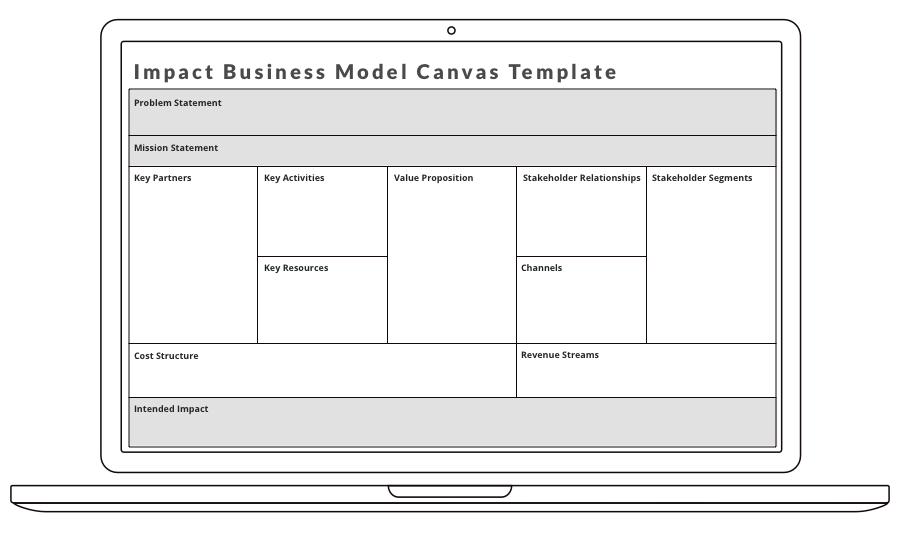
Figure 13: The Impact Business Model Canvas. Source: The impact BMC. (2020, November 18). Impact Business Model Canvas.
“The IBMC, or Impact Business Model Canvas, is a framework for visualizing, evaluating, and refining your business model to achieve both social and financial value.”[72]
This IBMC is a framework that helps social entrepreneurs generate commercial value and social impact. This Canvas is meant to push the user to consider all options in order to optimize both dimensions and evaluate the trade-offs between the commercial value and social impact. It is best to create two versions of the IBMC, one assuming a non-profit structure and another assuming a for profit model.
The Problem Statement is used to describe the social or environmental issue that the user seeks to address. The Mission Statement explains why the organization exists relative to the problem that is stated. From these two statements onwards, the user now has to figure out who they are going to serve and what product or services they will provide in order to address these problems. Your stakeholder segments likely include more than just customers and funders, a good understanding of your stakeholders and their diverse needs is critical in order to maximize the value you can deliver to each group. Your value proposition defines how you are solving problems and delivering benefits to your stakeholders in a new and better way. Your channels are the ways in which you will reach your stakeholders to deliver value. You need to figure out if your stakeholder relationships are low or high touch and thus how you will engage with your stakeholders. The key activities describe what you actually do to deliver value. Looking at the ecosystem to understand who is already working on the problem, or who needs to be part of the solution, will help you to identify key partners, and avoid reinventing the wheel. Your key resources include the human capital infrastructure, and various inputs required to perform your key activities. Once you have identified key resources, you should have a good sense of your cost structure and how much revenue you will need to sustain your activities. Then you have to consider how you will generate revenue streams to support the activities and cost structure you have described so you can sustainably deliver on your value proposition overtime. Your intended impact is the portion of the problem that you should aim to tackle which should be specific and measurable.[73]
5.2 Flourishing Business Canvas
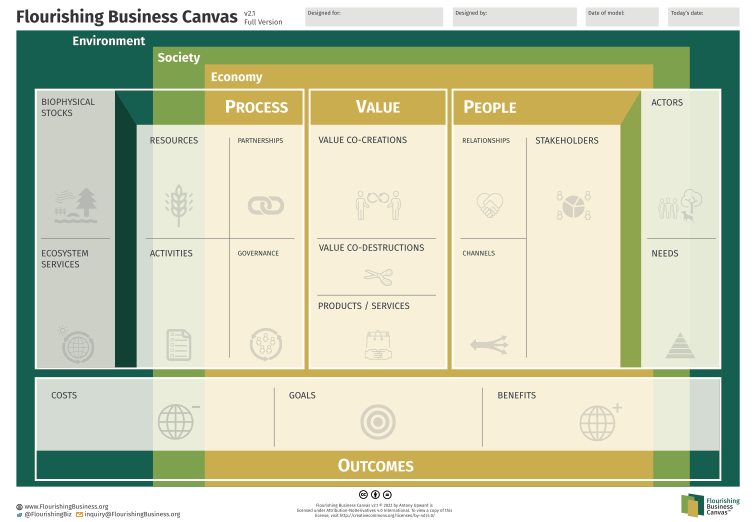
Figure 14: The Flourishig Business Canvas. Source: Download Flourishing Business Canvas. (2022, November 11). Flourishing Business.
The Flourishing Business Canvas (FBC) is a modified version of the regular Business Model Canvas (BMC) by Osterwalder and Pigneur, which adds a focus on social and ecological aspects. It can be seen as an upgrade to the regular BMC. It provides a common language for describing and designing enterprises based on any combination of stakeholders and their goals. The three contexts of the Flourishing Business Canvas (FBC) are the environment, the society and the economy. This Canvas Visualizes that a business is part of the economy, which is created by the society and that our society and the environment are interdependent. The FCB is divided into 4 perspectives which are considered by the company and has 17 segments in total.[74]
The 4 perspectives:
- Process: how, where and with what does this business co-create its value to achieve its Goals
- Value: what value is co-created and co-destroyed now and / or in the future between this business and all the Stakeholders involved
- People: who are all the people involved in this business: the people this business does it, for and with?
- Outcomes: what outcomes demonstrate whether this business has achieved its Goals, achieving its Stakeholders definition of success over time? How does this business measure the benefits and costs to determine whether or not these outcomes are achieved (in applicable environmental, social and monetary units)?
The 17 Segments:
Actors:
- Who and what may have an interest in the fact that this business exists?
- From which groups or pools of Actors do the people come from who play the role of Stakeholders in this business?
- Which individuals, groups or organizations does this business aim to reach and co-create value with to better meet those
- What are actor’s needs?
- Examples: People, NGOs, Government, Media, other life and nature (usually represented by an NGO) etc.
Needs:
- What fundamental needs of the actors is this business intending to satisfy or may hinder?
- Guidance: for inspiration one can review Maslow’s Hierarchy of Needs or Max-Neef’s Fundamental Human Needs
Stakeholders:
- How is each actor involved in this business?
- What stakeholder roles does each actor take?
- Examples: customer, employee, investor, supplier, community, regulator, financier
Relationships:
- What type of Relationships with each stakeholder must be established, cultivated and maintained by this business via its Channels in order for value to be co-created (or co-destroyed)?
- Examples: Become aware, build trust/ interest, decision making, co-create value, experience, collaborate/support, co-evolve
Channels:
- What Channels will be used by this business to communicate, interact, and to develop the required types of relationship with each stakeholder (and vice versa)?
- Examples: Retail, Face-to-Face, Internet, Phone, Mail, Transport
Value Co-Creations:
- What are the (positive) value propositions of this business?
- What value is co-created with each stakeholder, satisfying the Needs of the associated actor, from their perspective (world-view), now and /or in the future?
- Which value co-creations are associated with which Products/ Services?
Value Co-Destructions:
- What are the (negative) value propositions of this business?
- What value is co-destroyed for each stakeholder, hindering the satisfaction of the Needs of the associated actor, from their perspective (world-view), now and /or in the future?
Products / Services:
- What does this business offer and provide to its customer or client or user stakenuivers that co-creates value with the associated Actors to better meet their Needs?
- Which offers do customer or client or user Stakeholders pay the business for, realizing (at least financial) Benefits?
Partnerships:
- What formal partnership agreements/ contracts are required by this business?
- To which key Resources do these partnership agreements enable this business to gain preferred access? e.g. an agreement to supply raw materials
- Which critical Activities do these partnership agreements ensure are undertaken for this business? e.g. an agreement to deliver the Product/Service
Governance:
- Which Stakeholders get to make decisions about: which Actors are legitimate Stakeholders, the Goals of this business, its Value Co-creations and its Processes?
- What are the Governance arrangements for this business? i.e. which Stakeholders have the power to make decisions about what topics?
Resources:
- What are the key tangible and intangible Resources required in order to execute this business’s critical
- Activities and so achieve its Goals?
Activities:
- What Activities does this business perform to strive to achieve its Goals?
- What Activities enable each value co-creation or value co-destruction?
- What Activities create and deliver each product service?
Biophysical Stocks:
- What ultimate stocks provide the tangible key
- Resources that are moved, flow, and / or transformed by this business’s critical
- Activities to achieve its Goals?
- What biophysical materials – living and non-living – are required in order to co-create value for your Stakeholders?
- Guidance: As per laws of conservation of matter, all materials remain Biophysical Stocks somewhere on our single shared planet irrespective of this business’s Activities (past, present and anticipated future)
Ecosystem Services:
- Ecosystem services are processes powered by the sun that use Biophysical Stocks to create flows of benefits humans need: clean water, fresh air, vibrant soil, plant and animal growth etc.
- Which flows of these benefits are required by, harmed or improved by this business’s Activities?
- Example: See World Business Council for
- Sustainable Development (WBCSD)’s
- Corporate Ecosystem Service Review v2.0
Costs:
- How does this business choose to measure the Costs incurred by its business model (Environmentally, Socially, Economically)?
Goals:
- What is this business’s goal to success: environmentally, socially, economically?
- What are the Goals that the Stakeholders have agreed align with the why/purpose/vision they have chosen for this business (measure in appropriate units)?
5.3 Triple Layered Business Model Canvas
The Triple Layered Business Model Canvas (TLBMC) is a tool for visualizing and analyzing the different layers of a business model. It is an extension of the traditional Business Model Canvas (BMC) which is a popular tool for planning and organizing the design of a new business. The TLBMC build on top of the BMC and add another two layers of analysis: the Societal layer, and the Environmental layer.
The TLBMC is divided into three layers:
- Economic layer: This is the layer that most closely aligns with the traditional Business Model Canvas. It includes elements such as the value proposition, customer segments, revenue streams, and cost structure. This layer focuses on the financial performance and viability of the business.
- Environmental layer: This layer looks at the environmental impact of the business. It includes elements such as the company’s environmental footprint, its use of sustainable resources, and its ability to reduce its negative impact on the environment. This layer focus on the ecological impact of the business. The questions whether a product is easily recycled at the end of its life and thus reintegrated into the value cycle are covered in this layer.
- Societal layer: This layer examines the social impact of the business. It includes elements such as the company’s impact on society, its stakeholder engagement, and its ability to create shared value. It focuses on the societal and social impact of the business, the value it creates for different groups. The questions whether the products or services create a positive value for the general public are covered in this layer.
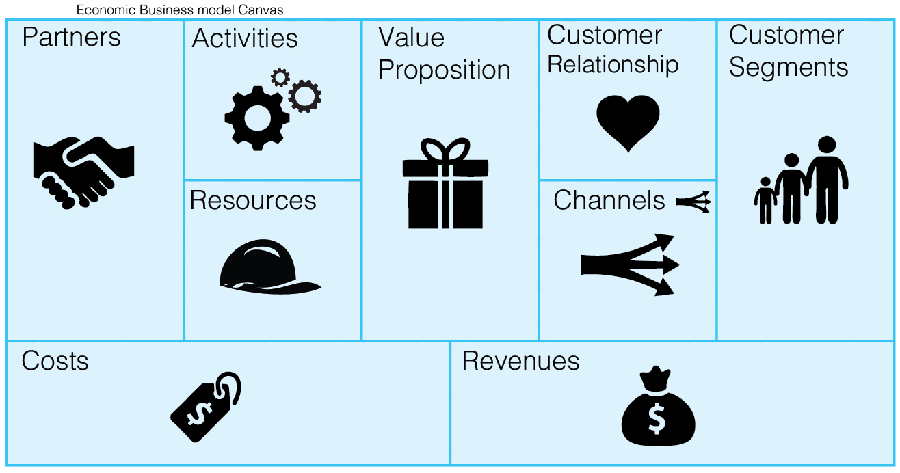
Figure 15: Economic Business Model Canvas. Source: Joyce, A., Paquin, R., & Pigneur, Y. 2015. The triple layered business model canvas: a tool to design more sustainable business models. ARTEM Organizational Creativity International Conference. Nancy, France.
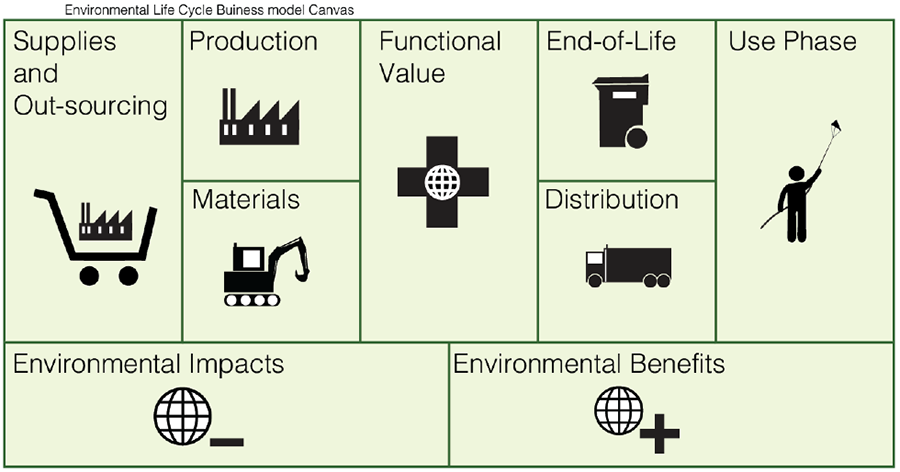
Figure 16: Environmental Business Model Canvas. Source: Joyce, A., Paquin, R., & Pigneur, Y. 2015. The triple layered business model canvas: a tool to design more sustainable business models. ARTEM Organizational Creativity International Conference. Nancy, France.
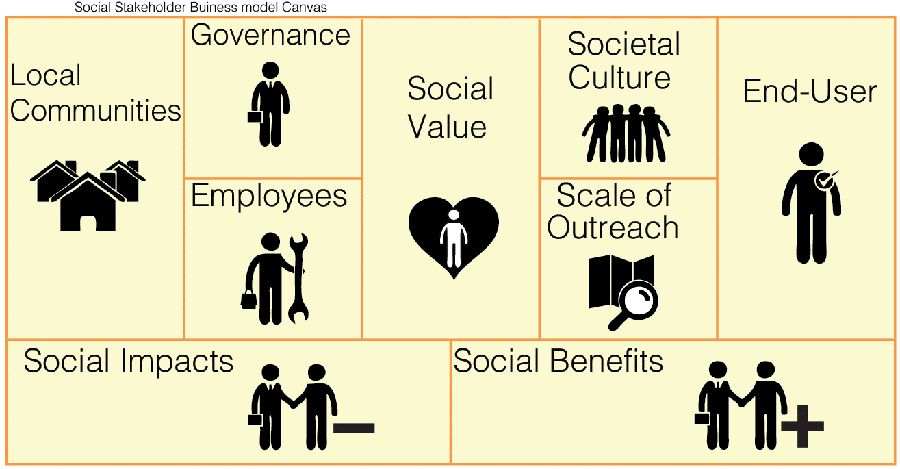
Figure 17: Social Business Model Canvas. Source: Joyce, A., Paquin, R., & Pigneur, Y. 2015. The triple layered business model canvas: a tool to design more sustainable business models. ARTEM Organizational Creativity International Conference. Nancy, France.
The TLBMC allows you to analyse the different layers of a business model and how they interact with one another, making it possible to identify potential trade-offs and opportunities for improving the overall sustainability of the business. It could be used in various stages of the business, from start-up phase to mature companies, to create a holistic vision of the business and the potential impact it could have in the different areas.[75]
In the following we will have a look at how a triple layered business model can look like using the example of Nespresso:
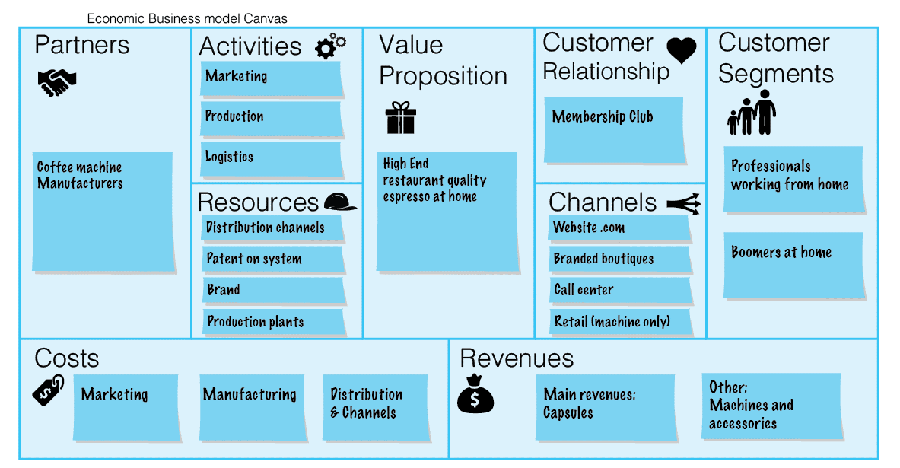
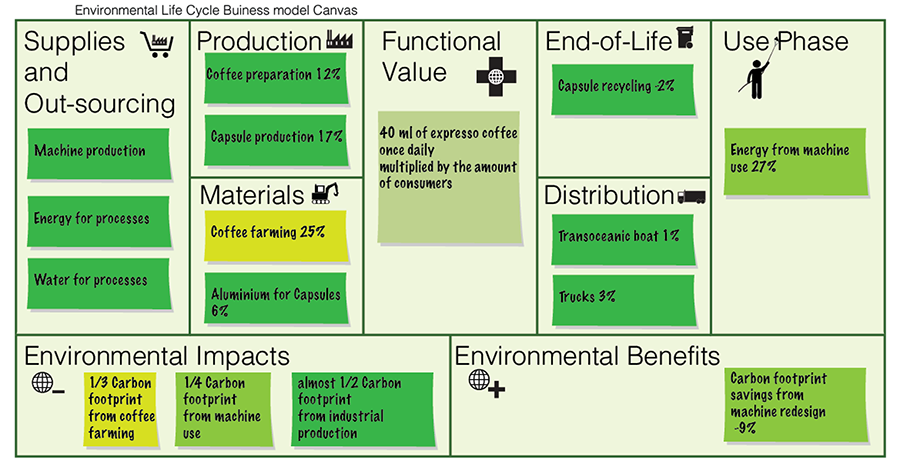
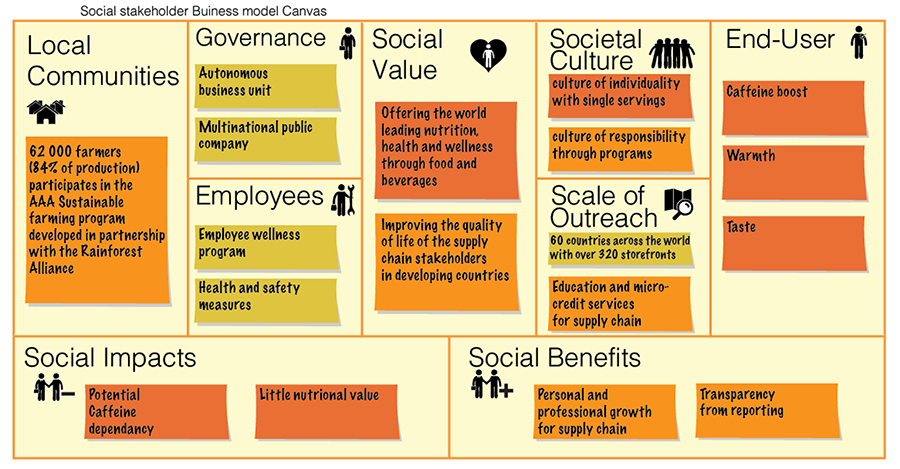
Source: Triple Layered Business Model Canvas Example Nespresso (Economic, Environmental, Social)
5.4 Zero Canvas
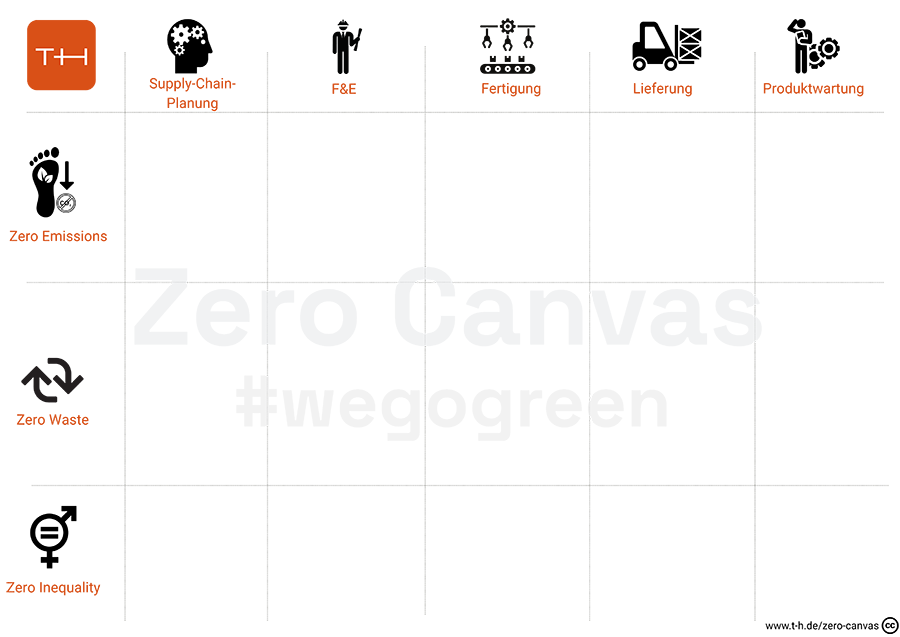
Figure 18: Zero Canvas. Source: Zero Canvas. (n.d.). T-h.de.
This Zero Canvas is a Business Model Canvas that shows a matrix, which includes the supply chain plan (Supply-Chain-Planung), research and development (F&E), production (Fertigung), delivery (Lieferung) and product maintenance (Produktwartung). On the Y-Dimension you can see zero emissions, zero waste and zero inequality.
Zero emissions target the CO2 emitting source, it is important to identify the source and try to eliminate or at least reduce it to its minimum. It is important to identify the CO2 emitting sources within the supply chain plan, research and development, production, delivery and maintenance, and reduce them to its minimum. Zero Waste is about the consistent avoidance of waste through inventory optimization or a redesign of the product according to rules of the circular economy. Lastly, zero inequality focuses on the fair treatment of the employees. Sustainability as defined by the United Nations within their 17 SDGs also explains equal opportunities, which are a focus of zero inequality. An example here would be human-centered designs of jobs and equal pay for equal work. [76]
5.5 Lean Impact Canvas
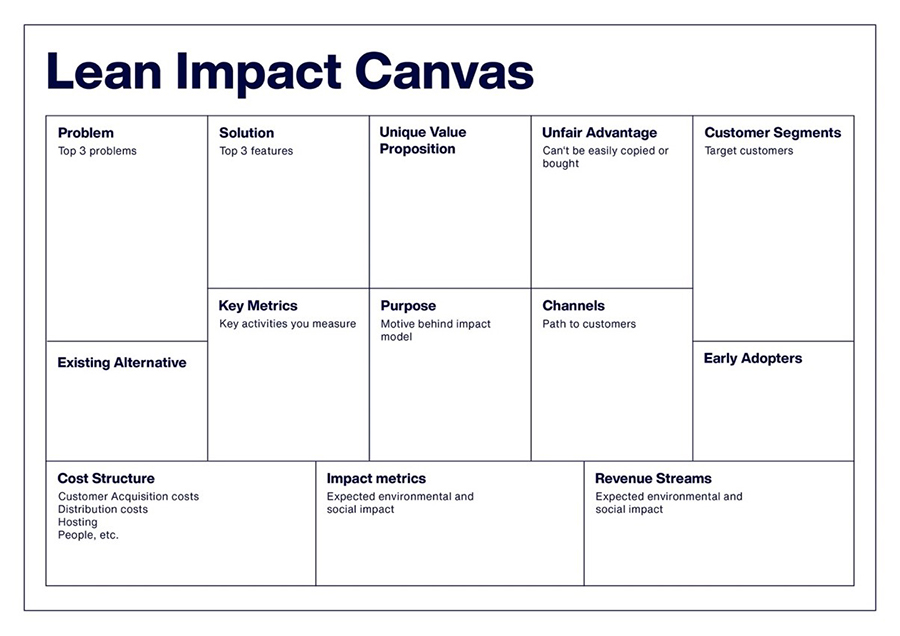
Figure 19: Lean Impact Canvas. Source: Hardt, B. (2021, October 4). Drei Tools für innovative und nachhaltige Geschäftsmodelle.
The Lean Impact Canvas by Ann Mei Chang is inspired by the Lean Startup by Eric Ries. Its terminologies and concepts are taken as a basis and expanded by the corporate purpose, as the heart of the canvas, and various social and ecological impact metrics. The canvas creates a common language for all relevant stakeholders and enables appropriate metrics to be identified in relation to the social and/or ecological contribution of the business idea.
Methodologically, the Lean Impact Canvas supports rapid repetitive cycles that are intended to guide the design of new business models and the testing of hypotheses in a more problem- and action-oriented manner. Questions addressed here include: While the idea is still in its green infancy, how can the business model be outlined quickly, pragmatically, and clearly to generate a positive impact? How can social and ecological problems be targeted and economic profitability ensured at the same time?[77]
5.6 The 4 Cs of environmental business
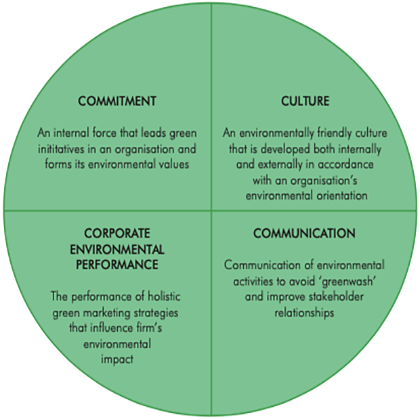
Figure 20: The 4 Cs of environmental business. Source: The 4 Cs of of environmental business: Introducing a new conceptual framework. Researchgate.net
The four key themes or ‘pillars’ were uncovered as the organisational prerequisites a company should satisfy in order to achieve environmental business excellence. These four pillar are: Commitment, Culture, Corporate Environmental Performance, and Communication.[78]
5.7 Problem tree analysis
The problem, objective and strategy tree analysis is one participatory tool of mapping out main problems, along with their causes and effects, supporting project planners to identify clear and manageable goals and the strategy of how to achieve them.
There are three stages in this analytic process:
- the identification of the negative aspects of an existing situation with their “causes and effects” in a problem tree
- the inversion of the problems into objectives leading into an objective tree
- the decision of the scope of the project in an analysis of strategies.
The value of this type of assessment is greatest if it is carried out in a workshop with the stakeholders, giving the opportunity to establish a shared view of the situation[79].
Here is an example of how a problem tree analysis can look like:
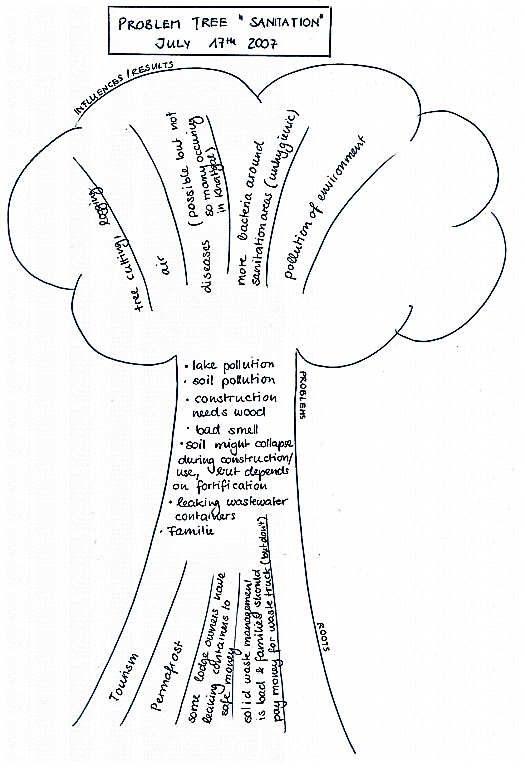
Figure 21: Problem Tree Analysis on the Topic “Sanitation”. Source: Problem Tree Analysis. (2010, September 2). Sswm.Info; seecon international gmbh.
6. Tools
6.1 Simplified GHG Emissions Calculator
The EPA Simplified GHG Emissions Calculator is designed as a simplified calculation tool to help small business and low emitter organizations estimate and inventory their annual greenhouse gas (GHG) emissions. The calculator will determine the direct and indirect emissions from all sources at a company when activity data are entered into the various sections of the workbook for one annual period.[80]
6.2 Scope 3 Evaluator
To help facilitate the adoption of the Scope 3 Standard, GHG Protocol teamed up with Quantis to develop this free scope 3 screening tool. This tool provides users a simple interface to make a first, rough approximation of their full scope 3 footprint, regardless of their organization type and size. The tool leads users through a series of questions about their organizational structure and their activities of various types, such as purchase of goods and services, use of fuels, transportation of materials, and more. Linking these inputs to a combination of economic input-output and process life cycle inventory data, the tool provides the user with a simple though complete scope 3 inventory which they can then use as an initial basis for identifying action areas, initial reporting or disclosure of their inventory, and for informing their future efforts to produce a more accurate inventory of emissions.[81]
7. Developing and piloting sustainable entrepreneurship training
The aim of this supportive research was to create the foundation for the development of the learning and training methodology and reflect it in a specific guideline – Digital Handbook on Sustainable Entrepreneurship for Climate Action (SECA guide) that provides step by step approach on how to create a sustainable business and develop a sustainable business idea. Considering the complexity of sustainability topic and wide range of established standards, methodologies and practices, variety of proposed approaches were piloted and iterated during the project with the participation of students, entrepreneurs and coaches. It served as a basis for the development of elaborated guide that helps to conduct a sustainable business development project. The piloting of the training started during the summer 2022 in FH Aachen UAS in Germany. Based on lessons learnt and feedback by the students further education methodology was developed. The following iteration of sustainable entrepreneurship training and piloting of the SECA guide draft version took place in Rovaniemi in Finland in spring 2023 and final implementation of the learning event took place again in Aachen in summer 2023.
7.1. Summer School on Sustainable Entrepreneurship
Hereby we provide an example of a one-week intensive study program – summer school that was conducted in FH Aachen.
Summer school is a methodology for implementation of intensive training on sustainable entrepreneurship and this example can serve as an inspiration for other education institutions in the future. Hereby is a description of possible implementation of a summer school as an example of a teaching method at the university.
The target groups of the summer school are all students from any university and any education background. The students gain the knowledge and practical skills on the topic of Sustainable Entrepreneurship and the ultimate outcome of the learning process is developed sustainable business idea that provides a sustainable value. This idea is turned into prototype and is tested with the user. The program of the summer school includes workshops, inspirational lectures, joint learning exchange as well as leisure time. Interdisciplinary teamwork is included and each participant receives a certificate of participation after the successful completion of the summer school program.
Example of one-week summer school agenda:

The program is designed following the learning steps required for the multidisciplinary teams to deliver the final outcome at the end of the week – developed and tested new sustainable business idea.

Following the agenda presented, the subsequent approaches are taken in the study week implementation.
Introduction is made with topics from this research report and the SECA guide – digital handbook. In addition to a general introduction to the concepts and terminology, best practices by companies are also presented so that the participants get a better idea about the realities of sustainable entrepreneurship.
Problem -Solution Tree (PST) is conducted with the intention of defining a problem that the teams would then work on during the week. This is a starting point for the teams where they identify sustainability and climate action related problems, seek solutions to it and come up with preliminary business idea.
Design Thinking method is used to create a sustainable value as a core of the business and it runs through the whole week. In the workshop participants are introduced to the method and learn how they can use Design Thinking tools to create sustainable product or service. Students use the tools of design thinking and work independently under the supervision of the coaches.
Exchange of the results by teams takes place in the middle of the process and ithas three advantages. First, the teams have the pressure to be able to present the progress. Second, we can see if the teams are moving in the right direction. And third, not only do we give feedback to a particular team, but also other teams can hear the feedback of others and therefore can learn from it. It is also inspiring for the teams to hear the ideas of others.
Pitch Training: the workshop is organized by one of our coaches and shows how a pitch is structured and how an idea can be presented well. This not only helps the teams during the final presentation, but also during the next few days they already know what they need to pay attention to and which aspects still need to be considered.
Working phases: the teams can work independently, but the coaches are always there for questions. We also introduce certain methods from the SECA guide and design thinking that the teams can optionally use.
3D printing / Lasercutter: if teams have an idea for a physical product, they will learn here how to create the first prototypes for it. They can use technology to conduct first tests or even visualize their idea at the final presentation. Experience shows that it is also exciting for the other participants to learn 3D printing in practice.
Pitches: teams present their sustainable business idea, on which they have worked for a week. In the best case, the teams or some of the participants continue to work on their idea and implement this idea in practice.
City Tour / BBQ: Voluntary activities such as city tour or dinner evening strengthens the team spirit and enables a relaxed exchange within the group but also with the coaches. Experience has shown that the participants also talk a lot about the Summer School topics or sustainability in general.
7.2. Summary of feedback by participants
After each iteration of the learning event on sustainable entrepreneurship, the participants were asked to provide a feedback, either in written or oral form. From the feedback in first iteration it was concluded that the participants are highly satisfied with the learning event as well as with the framework conditions (e.g. spatial/technical conditions, group size) (5 point out of 5, where 1 is considered very poor and 5 is excellent). Participants also were happy with the structure of the training (Æ4,5/5). The balance between learning and fun was appropriate according to participants (Æ 4,5/5) and the expectations of the week were met. (Æ 4,5/5).
Participants of the summer school in Aachen in particular liked
- Using 3D printing and laser cutting
- The collaborative atmosphere where we all were able to exchange ideas about different themes with ease
- Practical application and Workshops
- The input was put in the Program was great
- Open discussions with presenters
On the question “What was your key learning?” the participants answered:
- Entrepreneurship is as much about the idea as it is about the people implementing the idea
- Team Work
- Pitch Deck and Addressing particular problems
- Your network is one of your most valuable assets
- The concepts of the Sustainable entrepreneurship
- Fun and Educational
- Lots of learning and many good people
- Amazing opportunity to bring our ideas out and make new contacts
- Good environment to meet likeminded people.
- Wonderful and learned a lot
During the SECA guide piloting in Rovaniemi, Finland, similar approach was used in the implementation of the one week intensive learning program. Students were asked among other the question how your sustainable and green thinking has changed and understanding on SDGs and Climate Change over the week programme, students answered:
- I learned a lot more about all these subjects. I would love to continue learning more about it.
- My understanding for climate change changes by adding new perspectives. Sustainable and green thinking by adding new points of view
- My perspective has become broader, as I do not only think about sustainable products, but also ways to promote already existing sustainable solutions
- There is a huge need and every single step, no matter how small it is, it will make a difference. We as young Generation need to focus more strongly on Sustainability and also incentivise our social Environment
- I’m more aware of if the decisions I make are sustainable or not
- I really enjoyed the opportunity to be a part of this and my favorite parts of the whole week was getting to hear the real businesses like Pattern and Fantasia discuss their sustainable strategies and then express what their real problems were that they are currently facing.
To the question “Have you considered to start your own “sustainable” business in the future” most of the students were not sure yet, but many answers were really encouraging:
– Yes I have considered to create a service company to recycle a lot of renewable resources
– I will continue my own practice by implementing more sustainable thinking
– Yes, definitely. I will take idea of zero paper use and re-think how can my business idea can become part of circular economy
– The goal is to become a consultant who Supports businesses in many areas including sustainability
– I will definitely thing much more widely about how to use sustainable equipment, decorations, to arrange food areas.
– Yes. I was already thinking on starting a business, but now I will consider not only the profit, but how to maintain it responsible with the environment and society. Without doing that, the business will be a failure in a long term.
– I intend, somewhere in the future, to start a company that has heavy influences of sustainability and circular economy
Suggestions for improvement of summer school and weekly learning program included the following:
- More workshops
- A Mikrophone for the speaker so everyone can hear better
- Stricter time management
- I think all was good
- I would recommend to make the days less longer because at the end of the day, everyone was very tired and it was very tiring to do all the exercises
- Optional lectures, diversity of topics
- Little bit more time for tasks
It was an intention to learn how the methods emphasised in the SECA guide were useful for the learning and asked the question “How your knowledge and skills have improved over the study week programme on the following (1 is “very little” – 5 is “significantly”) – the results are reflected in this chart:
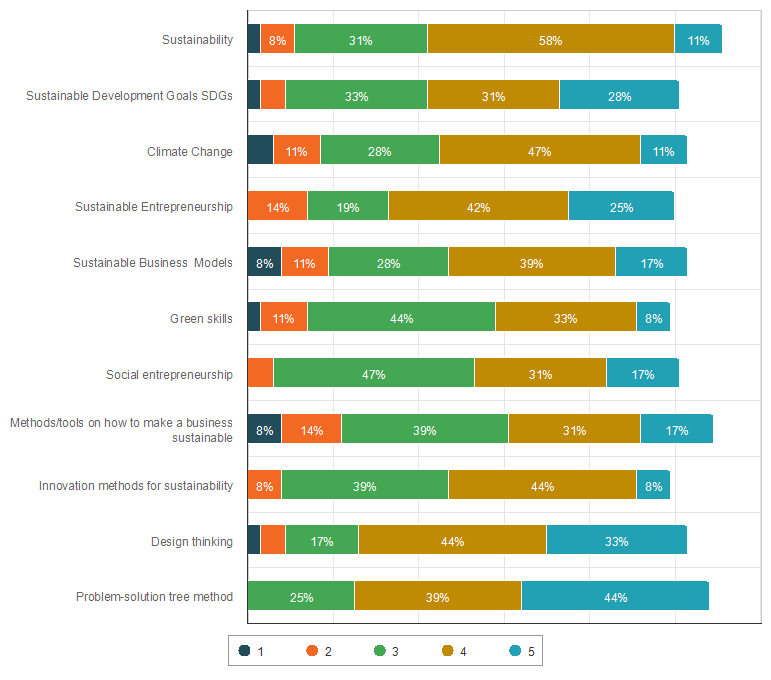
- Summarizing the feedback we can see that there is a room for minor improvements, such as ensure the time is sufficient for the teamwork and good duidance by coaches is crucial, however, the program based on the SECA guide approach proved to be very practical and useful in advancing sustainable entrepreneurship knowledge resulting in several business ideas that students wish to develop and implement in the future as their own business. The value of entire work of sustainable entrepreneurship research report and training development can be concluded by one citation of the program participant: ”I now understand how all small solutions combined together can make great impact to climate. A millions of drops make an ocean. A million of small actions make change.”
7.3. Development Proposals
Following the iteration process it the proposal is to redesign the one-week study program that follows SECA guide step-by-step approach.
Agenda proposal for the future intensive study weeks or summer schools.
| Monday | Tuesday | Wednesday | Thursday | Friday |
| Welcome and getting to know each other Terminology and concept of sustainable entrepreneurship Raising awareness of the topic (e.g. through a challenge or quiz) Team creation Problem-solution tree method | Company Case Study Design Thinking Apply tools and methods of Design Thinking Develop problem and solution idea Interviews and stakeholder analysis | Customer Validation Prototyping (through online tools) Testing Outdoor activities | Pitch Training Tools and Methods of Sustainable Entrepreneurship (Circularity principles 5R) Best Practices Outdoor activities | Finalising teamwork Pitches |
Online summer school. In the future the idea would be to prepare the contents in such a way that they only have to be made available as self-learning materials via an online school. Based on the observations and iteration of the learning events we conclude that the material produced in the project and the digital SECA guide can be further used in the form of an online training if adopted properly. Appointments for optional online consultation for feedback or questions should be made available. The problem-solution method and design thinking process should be included since it gives participants a good basis for developing their own problems and solutions and provides a common thread. It is also important to allow the common learning experience exchange among the participants, that enable mutual communication and interaction as well as peer learning within the group of learners.
Summer school over a longer period of time. For an extended-duration Summer school, it is beneficial to incorporate multiple milestones distributed across the program duration. Each milestone should come with a set deadline, accompanied by interim presentations and feedback sessions. This approach offers increased flexibility, requiring participants to manage their own coordination. Moreover, it presents an opportunity to delve deeper into topics, allowing the inclusion of supplementary information or additional topics for more comprehensive exploration.
8. Conclusion
This research into sustainable entrepreneurship has highlighted the complex landscape of terminologies, frameworks, and strategies crucial for fostering environmentally conscious businesses. There is wide range of definitions to sustainable entrepreneurship not only in academia, but also by countries marking the distinctions between Social Entrepreneurship and Sustainable Entrepreneurship. There is a need to understand the interconnectedness of frameworks like SDGs, CSR, and ESG, and this study has laid a robust foundation for understanding sustainability’s multifaceted realm. Discussing the SDG 13 – Climate Action, the pivotal role of mitigating climate change, and essential milestones such as the Paris Agreement and EU Green Deal, this research underscores their significance in combating global climate challenges. Examining relevant terminology, international standards, corporate strategies, and best practices offers a panoramic view of the diverse approaches and initiatives in sustainable entrepreneurship. Moreover, insights gained from the interviews with companies and the range of methodologies and tools presented equip future entrepreneurs with invaluable resources for navigating the complexities of sustainable business development. With the examples of the implementation of sustainable entrepreneurship training programs within the project, this study proposes a methodology based on iterative piloting, emphasizing a week-long intensive format tailored for universities to foster comprehensive education in sustainable entrepreneurship. The anticipated outcome is the development of a digital handbook, bridging knowledge gaps and empowering aspiring entrepreneurs to drive meaningful climate action through innovative and sustainable business practices.
Notice. The research was concluded by March 2023, ensuring the accuracy of the collected and analyzed data until that timeframe. Minor revisions and updates have been done in December, 2023.
9. References
Babor – THE GREEN AGENDA. (2010). Babor. https://de.babor.com/service/babor/about/nachhaltigkeit-verantwortung
Bak, W. (2022, June 30). SDGs, ESG, CSR, and Sustainability – how to avoid confusion about these terms and where to start the real change. Clouds On Mars. https://cloudsonmars.com/sdg-esg-csr-and-sustainability-how-to-avoid-confusion-about-these-terms-and-where-to-start-the-real-change/
Bourguignon, D. (2016). Closing the loop New circular economy package. Europa.Eu. https://www.europarl.europa.eu/RegData/etudes/BRIE/2016/573899/EPRS_BRI%282016%29573899_EN.pdf
Bowen, H. R. (2013). Social responsibilities of the businessman. University of Iowa Press.
Circular Economy – die Zukunft heißt Kreislaufwirtschaft. (2021, February 12). Umweltmission. https://umweltmission.de/wissen/circular-economy-kreislaufwirtschaft/
Circular economy: definition, importance and benefits. (2015, February 12). Europa.Eu. https://www.europarl.europa.eu/news/en/headlines/economy/20151201STO05603/circular-economy-definition-importance-and-benefits
Definition & Kriterien. (2021, February 15). SEND; SEND e.V. https://www.send-ev.de/social-entrepreneurship/definition-kriterien/
DIN EN ISO 14040 D. Www.h2.de. Retrieved February 18, 2023, from https://www.h2.de/fileadmin/user_upload/Einrichtungen/Hochschulbibliothek/Downloaddateien/DIN_EN_ISO_14040.pdf
DIN EN ISO 14044 D. Www.h2.de. Retrieved February 18, 2023, from https://www.h2.de/fileadmin/user_upload/Einrichtungen/Hochschulbibliothek/Downloaddateien/DIN_EN_ISO_14044.pdf
Download Flourishing Business Canvas. (2022, November 11). Flourishing Business. https://flourishingbusiness.org/download-flourishing-business-canvas/
Ecosia is the search engine that plants trees. Ecosia.org. Retrieved February 18, 2023, from https://info.ecosia.org/what
Environmental. Www.dictionary.com. Retrieved February 17, 2023, from https://www.dictionary.com/browse/environmental
EPR Toolbox. (2020, November 12). PREVENT Waste Alliance. https://prevent-waste.net/en/epr-toolbox/
Europäischer Grüner Deal. Europäische Kommission. Retrieved February 20, 2023, from https://commission.europa.eu/strategy-and-policy/priorities-2019-2024/european-green-deal_de
EU-Taxonomie für Unternehmen aller Größen relevant. (n.d.). Dihk.de. Retrieved February 18, 2023, from https://www.dihk.de/de/themen-und-positionen/wirtschaftspolitik/steuer-und-finanzpolitik/sustainable-finance-taxonomie-ein-dossier-fuer-die-betriebliche-praxis/eu-taxonomie-fuer-unternehmen-aller-groessen-relevant-66740
Getting ahead of the curve: Corporate strategies that address climate change. (2006, October 12). Center for Climate and Energy Solutions. https://www.c2es.org/document/getting-ahead-of-the-curve-corporate-strategies-that-address-climate-change/
Gigliotti, M., Schmidt-Traub, G., & Bastianoni, S. (2019). The sustainable development goals. In Encyclopedia of Ecology (pp. 426–431). Elsevier.
Goal 6: Clean water and sanitation. (2021, September 17). The Global Goals. https://www.globalgoals.org/goals/6-clean-water-and-sanitation/
Goal 7: Affordable and clean energy. (2021, September 17). The Global Goals. https://www.globalgoals.org/goals/7-affordable-and-clean-energy/
Goal 9: Industry, innovation and infrastructure. (2021, September 17). The Global Goals. https://www.globalgoals.org/goals/9-industry-innovation-and-infrastructure/
Goal 11: Sustainable cities and communities. (2021, September 17). The Global Goals. https://www.globalgoals.org/goals/11-sustainable-cities-and-communities/
Goal 12: Responsible consumption and production. (2021, September 17). The Global Goals. https://www.globalgoals.org/goals/12-responsible-consumption-and-production/
Goal 13: Climate action. (2021, September 17). The Global Goals. https://www.globalgoals.org/goals/13-climate-action/
Goal 14: Life below water. (2021, September 17). The Global Goals. https://www.globalgoals.org/goals/14-life-below-water/
Goal 15: Life on land. (2021, September 17). The Global Goals. https://www.globalgoals.org/goals/15-life-on-land/
Gunderson, G. A. (2013). Ecopreneurship. In Encyclopedia of Corporate Social Responsibility (pp. 909–915). Springer Berlin Heidelberg.
Hardt, B. (2021, October 4). Drei Tools für innovative und nachhaltige Geschäftsmodelle. https://zero360.de/blog/sustainable-business-model-innovation/
HARIBO international on LinkedIn: #photovoltaic #solarpark #haribo #solarenergy. (n.d.). Linkedin.com. Retrieved February 25, 2023, from https://bit.ly/41up9qK
Hyrogas – carbon free hydrogen. (n.d.). Hyrogas – Carbon Free Hydrogen. Retrieved February 26, 2023, from https://www.hyrogas.com/
InCSR. (2018, November 15). InCSR; Korporatīvās ilgtspējas un atbildības institūts. https://www.incsr.eu/par-mums/
ISO 14001:2015. (2021). ISO. https://www.iso.org/standard/60857.html
ISO 26000:2010. (2021). ISO. https://www.iso.org/standard/42546.html
Joyce, A., Paquin, R., & Pigneur. (2015). The triple layered business model canvas: A tool to design more sustainable business models. ARTEM Organizational Creativity International Conference.
Klimscha, F., & Lehner, M. (2021). EU-Taxonomie: Ihre Bedeutung für die Finanzierung der nachhaltigen Transformation des Europäischen Wirtschaftssystems. Nachhaltigkeits Recht, 1(3), 302. https://doi.org/10.33196/nr202103030201
Krastina, A., Nawrath, L., Bruksle, I. (2023). Sustainable Entrepreneurship for Climate Action. Digital Handbook on How to Innovate Sustainable Start-Ups and Businesses for Climate Action. Lapland University of Applied Sciences Ltd.
PDF-file: http://www.lapinamk.fi/loader.aspx?id=d3147694-7206-4f0a-a371-c0b23cc05e25
MÁDARA Cosmetics. (n.d.). Madaracosmetics.com. Retrieved February 26, 2023, from https://www.madaracosmetics.com/en/about
Labs of Latvia. (n.d.). Labsoflatvia.com. Retrieved February 26, 2023, from https://labsoflatvia.com/en/inspirational-stories/terrawaste-gives-plastic-waste-a-second-life
Lidojumi uz Eiropu un Tuvajiem Austrumiem. (n.d.). Airbaltic.com. Retrieved February 26, 2023, from https://www.airbaltic.com/lv-LV/index
Lumpkin, G. T., Katz, J. A. (2011). Advances in Entrepreneurship, Firm Emergence and Growth Volume 13, Social and Sustainable Entrepreneurship. Advances in Entrepreneurship, Firm Emergence and Growth, 13.
Market Prospects Insights (Publisher). What are SDGs, CSR, ESG? Do you know the differences? Market Prospects. Retrieved February 17, 2023, from https://www.market-prospects.com/articles/what-are-sdgs-csr-esg
McKinsey on Climate Change. (2020). Mckinsey.com. https://www.mckinsey.com/~/media/McKinsey/Business%20Functions/Sustainability/Our%20Insights/McKinsey%20on%20Climate%20Change/McKinsey-on-Climate%20Change-Report.pdf
NASA’s Global Climate Change website. Climate Change Adaptation and Mitigation. Climate Change: Vital Signs of the Planet. Retrieved February 17, 2023, from https://climate.nasa.gov/solutions/adaptation-mitigation/
Piwowar-Sulej, K., Krzywonos, M., & Kwil, I. (2021). Environmental entrepreneurship – Bibliometric and content analysis of the subject literature based on H-Core. Journal of Cleaner Production, 295(126277), 126277. https://doi.org/10.1016/j.jclepro.2021.126277
Privāts » Omniva. (n.d.). Omniva.Lv. Retrieved February 26, 2023, from https://www.omniva.lv/
Problem Tree Analysis. (2010, September 2). Sswm.Info; seecon international gmbh. https://sswm.info/taxonomy/term/2647/problem-tree-analysis
RECUP & REBOWL – Deutschlands größtes Mehrwegsystem für die Gastronomie. (2020, August 19). RECUP / REBOWL. https://recup.de/
Rimi – Sustainability. (n.d.). Rimibaltic.com. Retrieved February 26, 2023, from https://www.rimibaltic.com/sustainability
Rupini, D. Berenberg.de. Retrieved February 18, 2023, from https://www.berenberg.de/fileadmin/web/asset_management/news/esg-news/SDG_understanding_SDGs_in_sustainable_investing.pdf
Scope 3 Evaluator. Retrieved February 18, 2023, from https://quantis-suite.com/Scope-3-Evaluator/
Simplified GHG emissions calculator. (2015). https://www.epa.gov/climateleadership/simplified-ghg-emissions-calculator
Zero Waste definition. Zero Waste International Alliance. https://zwia.org/zero-waste-definition/
Strategy Cleanup – everwave. (2020, October 8). everwave – Werde teil der Welle, die unsere Meere rettet; everwave GmbH. https://everwave.de/strategy/
Tella, M. Kestävä yrittäjyys – Proakatemian esseepankki. Proakatemia.fi. Retrieved February 18, 2023, from https://esseepankki.proakatemia.fi/kestava-yrittajyys/
The 4 Cs of of environmental business: Introducing a new conceptual framework. (n.d.). Researchgate.net. Retrieved February 18, 2023, from https://www.researchgate.net/publication/272397482_The_4_Cs_of_environmental_business_Introducing_a_new_conceptual_framework
The impact BMC. (2020, November 18). Impact Business Model Canvas. https://www.impactbusinessmodelcanvas.com/
The Paris Agreement – What is the Paris Agreement? (n.d.). Unfccc.int. Retrieved February 18, 2023, from https://unfccc.int/process-and-meetings/the-paris-agreement
traceless. traceless. Retrieved February 18, 2023, from https://www.traceless.eu/about-us
Umwelt. (n.d.). HARIBO. Retrieved February 25, 2023, from https://www.haribo.com/de-de/ueber-uns/cr/umwelt
United Nations. Sustainable development goals | united nations. Retrieved February 18, 2023, from https://www.un.org/en/sustainable-development-goals
Was bedeutet Net Zero wirklich? . ClimatePartner. Retrieved February 18, 2023, from https://www.climatepartner.com/de/news/was-bedeutet-net-zero-wirklich
Was ist Zero Waste? (2022, May 1). Zero Waste Germany e. V. https://zerowastegermany.de/verein/was-ist-zero-waste/
Was ist Zero Waste? Definition und Leitfaden. (2021, July 8). Umweltmission. https://umweltmission.de/wissen/zero-waste/
What are SDGs, CSR, ESG? Do you know the differences? (n.d.). Market-prospects.com. Retrieved February 18, 2023, from https://www.market-prospects.com/articles/what-are-sdgs-csr-esg
What we do. Ellenmacarthurfoundation.org. Retrieved February 18, 2023, from https://ellenmacarthurfoundation.org/about-us/what-we-do
Wikipedia contributors. (2022, November 14). ISO 14000. Wikipedia, The Free Encyclopedia. https://en.wikipedia.org/w/index.php?title=ISO_14000&oldid=1121821774
Zero Canvas. T-h.de. Retrieved February 18, 2023, from https://www.t-h.de/intelligente-fabrik/nachhaltige-produktion-einer-intelligenten-fabrik/zero-canvas-nachhaltiger-produzieren-entlang-der-gesamten-wertschoepfungskette
Ksalatvija.Lv. Retrieved February 18, 2023, from http://www.ksalatvija.lv/lv
[1] Mair, J., Martí, I. (2006): Social entrepreneurship research: A source of explanation, prediction, and delight. Journal of Business Venturing, 21(5), p- 577-588.; Manikandan, S., Muthu, S. S. (2017): Social and sustainable entrepreneurship – Dimensions of difference and similarity. Journal of Cleaner Production, 162, 202-214.
[2] Lumpkin, G. T., Katz, J. A. (2011). Advances in Entrepreneurship, Firm Emergence and Growth Volume 13, Social and Sustainable Entrepreneurship. Advances in Entrepreneurship, Firm Emergence and Growth, 13.
[3] Oestreicher, F. (2017): Social Entrepreneurship und Sustainable Entrepreneurship: Verwandt oder verschwägert? https://www.hilfswerft.de/2017/08/30/social-entrepreneurship-und-sustainable-entrepreneurship/
[4] Lumpkin, G. T., Katz, J. A. (2011); Social and Sustainability Entrepreneurship, Bingley, p. XVII
[5] Tella, M. (n.d.). Kestävä yrittäjyys – Proakatemian esseepankki. Proakatemia.fi. Retrieved February 18, 2023, from https://esseepankki.proakatemia.fi/kestava-yrittajyys/
[6] InCSR. (2018, November 15). InCSR; Korporatīvās ilgtspējas un atbildības institūts. https://www.incsr.eu/par-mums/
[7] Ksalatvija.Lv. Retrieved February 18, 2023, from http://www.ksalatvija.lv/lv
[8] Bak, W. (2022, June 30). SDGs, ESG, CSR, and Sustainability – how to avoid confusion about these terms and where to start the real change. Clouds On Mars. https://cloudsonmars.com/sdg-esg-csr-and-sustainability-how-to-avoid-confusion-about-these-terms-and-where-to-start-the-real-change/
[9] Bowen, H. R. (2013). Social responsibilities of the businessman. University of Iowa Press.
[10] Bak, W. (2022, June 30). SDGs, ESG, CSR, and Sustainability – how to avoid confusion about these terms and where to start the real change. Clouds On Mars. https://cloudsonmars.com/sdg-esg-csr-and-sustainability-how-to-avoid-confusion-about-these-terms-and-where-to-start-the-real-change/
[11] Market Prospects Insights (Publisher). (n.d.). What are SDGs, CSR, ESG? Do you know the differences? Market Prospects. Retrieved February 17, 2023, https://www.market-prospects.com/articles/what-are-sdgs-csr-esg
[12] Bak, W. (2022, June 30). SDGs, ESG, CSR, and Sustainability – how to avoid confusion about these terms and where to start the real change. Clouds On Mars. https://cloudsonmars.com/sdg-esg-csr-and-sustainability-how-to-avoid-confusion-about-these-terms-and-where-to-start-the-real-change/
[13] https://reports.lindt-spruengli.com/geschaeftsbericht-2021/services/downloads.html
[14] One example is the GRI Standard, an easy-to-use reporting guide for ESG analysis. https://www.globalreporting.org/about-gri/
[15] Bak, W. (2022, June 30). SDGs, ESG, CSR, and Sustainability – how to avoid confusion about these terms and where to start the real change. Clouds On Mars. https://cloudsonmars.com/sdg-esg-csr-and-sustainability-how-to-avoid-confusion-about-these-terms-and-where-to-start-the-real-change/
[16] Gigliotti, M., Schmidt-Traub, G., & Bastianoni, S. (2019). The sustainable development goals. In Encyclopedia of Ecology (S. 426–431). Elsevier. https://www.undp.org/sustainable-development-goals
[17] Goal 6: Clean water and sanitation. (2021, September 17). The Global Goals. https://www.globalgoals.org/goals/6-clean-water-and-sanitation/
[18] Goal 7: Affordable and clean energy. (2021, September 17). The Global Goals. https://www.globalgoals.org/goals/7-affordable-and-clean-energy/
[19] Goal 9: Industry, innovation and infrastructure. (2021, September 17). The Global Goals. https://www.globalgoals.org/goals/9-industry-innovation-and-infrastructure/
[20] Goal 11: Sustainable cities and communities. (2021, September 17). The Global Goals. https://www.globalgoals.org/goals/11-sustainable-cities-and-communities/
[21] Goal 12: Responsible consumption and production. (2021, September 17). The Global Goals. https://www.globalgoals.org/goals/12-responsible-consumption-and-production/
[22] Goal 13: Climate action. (2021, September 17). The Global Goals. https://www.globalgoals.org/goals/13-climate-action/
[23] Goal 14: Life below water. (2021, September 17). The Global Goals. https://www.globalgoals.org/goals/14-life-below-water/
[24] Goal 15: Life on land. (2021, September 17). The Global Goals. https://www.globalgoals.org/goals/15-life-on-land/
[25] Goal 13: Climate action. (2021, September 17). The Global Goals. https://www.globalgoals.org/goals/13-climate-action/
[26] NASA’s Global Climate Change website. (o. J.). Climate Change Adaptation and Mitigation. Climate Change: Vital Signs of the Planet. https://climate.nasa.gov/solutions/adaptation-mitigation/
[27] The Paris Agreement – What is the Paris Agreement? (o. J.). Unfccc.int. https://unfccc.int/process-and-meetings/the-paris-agreement
[28] Europäischer Grüner Deal. Europäische Kommission. Retrieved February 20, 2023, from https://commission.europa.eu/strategy-and-policy/priorities-2019-2024/european-green-deal_de
[29] Environmental. (o. J.). Www.dictionary.com. https://www.dictionary.com/browse/environmental
[30] Gunderson, G. A. (2013). Ecopreneurship. In Encyclopedia of Corporate Social Responsibility (S. 909–915). Springer Berlin Heidelberg. https://link.springer.com/referenceworkentry/10.1007/978-3-642-28036-8_266
[31] Piwowar-Sulej, K., Krzywonos, M., & Kwil, I. (2021). Environmental entrepreneurship – Bibliometric and content analysis of the subject literature based on H-Core. Journal of Cleaner Production, 295(126277), 126277. https://doi.org/10.1016/j.jclepro.2021.126277
[32] Sparnicht, C. (2018, Juni 24). Zero Waste definition. Zero Waste International Alliance. https://zwia.org/zero-waste-definition/
[33] Was ist Zero Waste? (2022, Mai 1). Zero Waste Germany e. V. https://zerowastegermany.de/verein/was-ist-zero-waste/
[34] Was ist Zero Waste? (2022, Mai 1). Zero Waste Germany e. V. https://zerowastegermany.de/verein/was-ist-zero-waste/
[35] Was ist Zero Waste? Definition und Leitfaden. (2021, July 8). Umweltmission. https://umweltmission.de/wissen/zero-waste/
[36] Was bedeutet Net Zero wirklich? (n.d.). ClimatePartner. Retrieved February 18, 2023, from https://www.climatepartner.com/de/news/was-bedeutet-net-zero-wirklich
[37] Circular economy: definition, importance and benefits. (2015, February 12). Europa.Eu. https://www.europarl.europa.eu/news/en/headlines/economy/20151201STO05603/circular-economy-definition-importance-and-benefits
[38] Bourguignon, D. (2016). Closing the loop New circular economy package. Europa.Eu. https://www.europarl.europa.eu/RegData/etudes/BRIE/2016/573899/EPRS_BRI%282016%29573899_EN.pdf
[39] Circular Economy – die Zukunft heißt Kreislaufwirtschaft. (2021, February 12). Umweltmission. https://umweltmission.de/wissen/circular-economy-kreislaufwirtschaft/
[40] Klimscha, F., & Lehner, M. (2021). EU-Taxonomie: Ihre Bedeutung für die Finanzierung der nachhaltigen Transformation des Europäischen Wirtschaftssystems. Nachhaltigkeits Recht, 1(3), 302. https://doi.org/10.33196/nr202103030201
[41] EU-Taxonomie für Unternehmen aller Größen relevant. (n.d.). Dihk.de. Retrieved February 18, 2023, from https://www.dihk.de/de/themen-und-positionen/wirtschaftspolitik/steuer-und-finanzpolitik/sustainable-finance-taxonomie-ein-dossier-fuer-die-betriebliche-praxis/eu-taxonomie-fuer-unternehmen-aller-groessen-relevant-66740
[42] EPR Toolbox. (2020, November 12). PREVENT Waste Alliance. https://prevent-waste.net/en/epr-toolbox/
[43] Wikipedia contributors. (2022, November 14). ISO 14000. Wikipedia, The Free Encyclopedia. https://en.wikipedia.org/w/index.php?title=ISO_14000&oldid=1121821774
[44] ISO 14001:2015. (2021). ISO. https://www.iso.org/standard/60857.html
[45] ISO 14040:1997E
[46] ISO 14040:1997E
[47] DIN EN ISO 14040 D. (n.d.). Www.h2.de. Retrieved February 18, 2023, from https://www.h2.de/fileadmin/user_upload/Einrichtungen/Hochschulbibliothek/Downloaddateien/DIN_EN_ISO_14040.pdf
[48] ISO 14040:1997E
[49] ISO 14040:1997E
[50] ISO 14040:1997E
[51] ISO 14040:1997E
[52] DIN EN ISO 14044 D. (n.d.). Www.h2.de. Retrieved February 18, 2023, from https://www.h2.de/fileadmin/user_upload/Einrichtungen/Hochschulbibliothek/Downloaddateien/DIN_EN_ISO_14044.pdf
[53] DIN EN ISO 14044 D. (n.d.). Www.h2.de. Retrieved February 18, 2023, from https://www.h2.de/fileadmin/user_upload/Einrichtungen/Hochschulbibliothek/Downloaddateien/DIN_EN_ISO_14044.pdf
[54] DIN EN ISO 14044 D. (n.d.). Www.h2.de. Retrieved February 18, 2023, from https://www.h2.de/fileadmin/user_upload/Einrichtungen/Hochschulbibliothek/Downloaddateien/DIN_EN_ISO_14044.pdf
[55] ISO 26000:2010. (2021). ISO. https://www.iso.org/obp/ui/#iso:std:iso:26000:ed-1:v1:en
[56] McKinsey on Climate Change. (2020). Mckinsey.com. https://www.mckinsey.com/~/media/McKinsey/Business%20Functions/Sustainability/Our%20Insights/McKinsey%20on%20Climate%20Change/McKinsey-on-Climate%20Change-Report.pdf
[57] Getting ahead of the curve: Corporate strategies that address climate change. (2006, October 12). Center for Climate and Energy Solutions. https://www.c2es.org/document/getting-ahead-of-the-curve-corporate-strategies-that-address-climate-change/
[58] Ecosia is the search engine that plants trees. (n.d.). Ecosia.org. Retrieved February 18, 2023, from https://info.ecosia.org/what
[59] Strategy Cleanup – everwave. (2020, October 8). everwave – Werde teil der Welle, die unsere Meere rettet; everwave GmbH. https://everwave.de/strategy/
[60] Babor – THE GREEN AGENDA. (2010). Babor. https://de.babor.com/service/babor/about/nachhaltigkeit-verantwortung
[61] What we do. (n.d.). Ellenmacarthurfoundation.org. Retrieved February 18, 2023, from https://ellenmacarthurfoundation.org/about-us/what-we-do
[62] traceless. (n.d.). traceless. Retrieved February 18, 2023, from https://www.traceless.eu/about-us
[63] RECUP & REBOWL – Deutschlands größtes Mehrwegsystem für die Gastronomie. (2020, August 19). RECUP / REBOWL. https://recup.de/
[64] Umwelt. (n.d.). HARIBO. Retrieved February 25, 2023, from https://www.haribo.com/de-de/ueber-uns/cr/umwelt
[65] HARIBO international on LinkedIn: #photovoltaic #solarpark #haribo #solarenergy. (n.d.). Linkedin.com. Retrieved February 25, 2023, from https://bit.ly/41up9qK
[66] MÁDARA Cosmetics. (n.d.). Madaracosmetics.com. Retrieved February 26, 2023, from https://www.madaracosmetics.com/en/about
[67] Rimi – Sustainability. (n.d.). Rimibaltic.com. Retrieved February 26, 2023, from https://www.rimibaltic.com/sustainability
[68] Lidojumi uz Eiropu un Tuvajiem Austrumiem. (n.d.). Airbaltic.com. Retrieved February 26, 2023, from https://www.airbaltic.com/lv-LV/index
[69] Privāts » Omniva. (n.d.). Omniva.Lv. Retrieved February 26, 2023, from https://www.omniva.lv/
[70] Hyrogas – carbon free hydrogen. (n.d.). Hyrogas – Carbon Free Hydrogen. Retrieved February 26, 2023, from https://www.hyrogas.com/
[71] Labs of Latvia. (n.d.). Labsoflatvia.com. Retrieved February 26, 2023, from https://labsoflatvia.com/en/inspirational-stories/terrawaste-gives-plastic-waste-a-second-life
[72] The impact BMC. (2020, November 18). Impact Business Model Canvas. https://www.impactbusinessmodelcanvas.com/
[73] The impact BMC. (2020, November 18). Impact Business Model Canvas. https://www.impactbusinessmodelcanvas.com/
[74] Download Flourishing Business Canvas. (2022, November 11). Flourishing Business. https://flourishingbusiness.org/download-flourishing-business-canvas/
[75] Joyce, A., Paquin, R., & Pigneur, Y. 2015. The triple layered business model canvas: a tool to design more sustainable business models. ARTEM Organizational Creativity International Conference. Nancy, France.
[76] Zero Canvas. (n.d.). T-h.de. Retrieved February 18, 2023, from https://www.t-h.de/intelligente-fabrik/nachhaltige-produktion-einer-intelligenten-fabrik/zero-canvas-nachhaltiger-produzieren-entlang-der-gesamten-wertschoepfungskette
[77] Hardt, B. (2021, October 4). Drei Tools für innovative und nachhaltige Geschäftsmodelle. https://zero360.de/blog/sustainable-business-model-innovation/
[78] The 4 Cs of of environmental business: Introducing a new conceptual framework. (n.d.). Researchgate.net. Retrieved February 18, 2023, from https://www.researchgate.net/publication/272397482_The_4_Cs_of_environmental_business_Introducing_a_new_conceptual_framework
[79] Problem Tree Analysis. (2010, September 2). Sswm.Info; seecon international gmbh. https://sswm.info/taxonomy/term/2647/problem-tree-analysis
[80] Simplified GHG emissions calculator. (2015). https://www.epa.gov/climateleadership/simplified-ghg-emissions-calculator
[81] Scope 3 Evaluator. (n.d.). Retrieved February 18, 2023, from https://quantis-suite.com/Scope-3-Evaluator/
